| Glossary Of Giclee Terms
[305] |
1 ^^Top
16-bit Bits (the 1s and 0s of computer code) determine the detail in each pixel of a digitized image. The more bits, the more color possibilities available for your image. A higher bit count results in a perceived better image quality - smoother gradients (transitions between colors) and deeper shadows. 16-bit is better than 8-bit, and can be digitally changed in image editing software. |
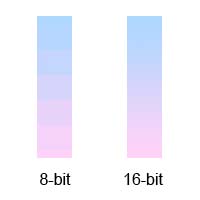 |
8 ^^Top
8-bit Bits (the 1s and 0s of computer code) determine the detail in each pixel of a digitized image. The more bits, the more color possibilities available for your image. A higher bit count results in a perceived better image quality - smoother gradients (transitions between colors) and deeper shadows. 8-bit is lower quality than 12-, 14- or 16-bit, but can be digitally changed in image editing software. |
A
Abrasion test The act of putting or exposing a material against the elements in order to determine their resistance to scratching under a specified set of conditions. Materials can include metals, composites, ceramics or thick spray coatings (such as the matte UV coatings sprayed on printed canvas). Fabrics are also put under abrasion test as well, to observe their durability, resistance and wear. |
| Abstract art An art style that avoids realistic and recognizable imagery, and instead depicts emotion through compositions of color and shape. Abstract art began to shift to the mainstream around the turn of the 20th century, as artists sought new ways to express their interpretations of the world. |
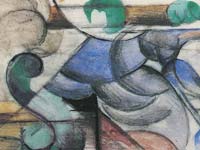 |
| Acid-free Paper materials with a pH of around 7 are considered to be acid-free. These materials are less likely to harm artwork over time. Materials with a pH below 6.5 or above a pH of 8.5 are not considered acid-free. |
 |
| Alignment Marks Alignment marks, also known as registration marks, are visual indicators used in the printing process to ensure accurate and consistent positioning of multiple layers or colors. These marks are typically small, easily identifiable symbols or targets placed strategically on each layer of the artwork. By aligning these marks during the printing process, printers can ensure that each color or layer lines up correctly, preventing misalignment or offsetting issues that could affect the quality of the final print. Printers use alignment marks strategically placed on each layer of the artwork to ensure perfect registration, enabling the accurate superimposition of colors and layers in the Giclée printing process. |
| Alkaline Paper A pH neutral paper that is generally processed with calcium carbonate, the alkaline substance most commonly used in art production. Alkaline papers are acid-free and conservation-grade. |
| Allover Painting An artwork in which the entire surface is painted from corner to corner, with no one section receiving more attention or significance. Many of Jackson Pollock's Abstract Expressionism paintings can be defined as such. |
| Aluminyzed Prints Aluminyze prints are images infused directly into a sheet of aluminium using a hot press - a process called sublimation. The result? A vibrant and durable print with unparalleled colour and depth. |
| Analog Printing Analog printing in the context of Giclée refers to traditional printing methods that utilize physical processes, such as lithography or screen printing, to transfer an image onto a substrate. Unlike digital printing, which involves the direct reproduction of digital files, analog printing relies on mechanical or chemical means to create prints. While digital printing offers precise control and flexibility, analog printing methods often provide unique textures and characteristics that appeal to artists and collectors seeking a more tactile and artisanal aesthetic. |
| ANSI The American National Standards Institute. This national group determines the guidelines governing a wide variety of commercially produced goods. |
| Anti-Aliasing Anti-aliasing is a digital image processing technique used in Giclée printing to reduce the appearance of jagged or stair-stepped edges (aliasing) in computer-generated graphics or text. By smoothing out these edges through the blending of adjacent pixels, anti-aliasing creates a more natural and visually pleasing appearance, especially when images are scaled or displayed at different resolutions. This technique helps to maintain the smoothness and clarity of fine details in Giclée prints, resulting in crisp, high-quality reproductions of digital artwork. |
| Anti-Glare Coating An anti-glare coating is a specialized finish applied to the surface of Giclée prints to reduce glare and reflections, improving their visibility and readability under various lighting conditions. This coating typically consists of a microscopically textured layer that diffuses incoming light, minimizing specular reflections and glare without significantly affecting the color or sharpness of the printed image. Anti-glare coatings are especially beneficial for artworks displayed in brightly lit environments or areas with direct sunlight, enhancing the viewing experience and ensuring that the details of the print remain clear and visible. |
| Anti-Reflective Coating An anti-reflective coating is a thin, transparent layer applied to the surface of Giclée prints to minimize reflections and glare. Unlike anti-glare coatings, which diffuse light to reduce glare, anti-reflective coatings work by altering the refractive index of the surface, allowing more light to pass through and less to be reflected. This results in improved clarity and visibility of the printed image, particularly when viewing from different angles or under bright lighting conditions. |
Aqueous-Based Printers Aqueous-based printers, so called because the ink used is primarily water mixed with either dyes or pigments, are widely used for canvas printing and typically offer the best image quality.
Most print shops have moved to pigmented inks because these inks provide a more urable print than dye inks; pigmented inks are now the standard. |
Archival Archival framing means that all the materials involved in the process are completely acid-free. Your artwork is framed to last.
An original artwork can be considered archival if no irreversible treatments (such as lamination or dry mounting) are applied, and the framing products involved are of archival quality. |
| Archival Ink Pigment inks designed for longevity. These inks resist fading and produce conservation-grade prints that will last for decades. |
| Archival Products Any professional-grade fine art paper, mat board, backing or acrylic that is acid-free and constructed to maintain its color and condition, and protect the artwork, for approximately 100 years. |
| Archival-stub Framing materials designed to keep artwork undamaged and intact for as long as it is displayed (as many as 100 years), under moderate circumstances. Also called conservation-grade or museum-grade. |
| Art Paper Art paper refers to a high-quality, archival-grade paper specifically designed for Giclée printing and fine art reproductions. These papers are typically made from acid-free or cotton rag materials, which ensures longevity and prevents yellowing or deterioration over time. Art papers come in various weights, textures, and finishes to suit different artistic preferences and printing requirements, offering options such as smooth matte, textured watercolor, or glossy surfaces to enhance the visual impact of the printed artwork. |
Artist Canvas Any canvas material intended and prepared for painting or other art mediums. Artist canvas is available on rolls, or pre-mounted on wood frames. Today, most canvas is made from cotton and linen, though hemp was common in the past. The canvas may be primed or unprimed, depending on the artists preference.
Order online:
Mounted Artist Canvas
Rolled Artist Canvas |
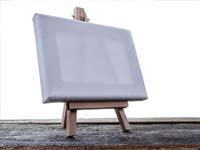 |
| Artist's Proof A term used to distinguish a small number of perfect example prints from an edition. Usually an extra 10% not included in the total number of a limited edition. Generally the property of the artist and numbered in Roman numerals. |
| Artwork Width When ordering a frame, you will be asked to provide a “width” measurement. This is always the horizontal measurement of the artwork you are framing. Measure your piece from left to right. It is important to ensure the ruler or measuring tape is straight (the same distance from the top on each side) and the recorded measurement is accurate to within 1/16th of an inch. |
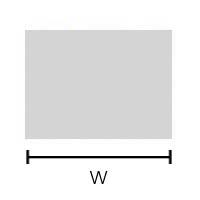 |
| Aspect Ratio The relationship between the height of your photo or artwork to its length is called the aspect ratio. |
B ^^Top
Backing Board A backing board is a rigid support material used to provide structural stability and protection to Giclée prints when framing or displaying them. Typically made from materials like foam core, cardboard, or archival-quality paperboard, backing boards prevent prints from warping, bending, or sagging over time by providing a flat, even surface for mounting. Additionally, backing boards help to isolate prints from external factors like moisture, dust, and handling, preserving their integrity and prolonging their lifespan. |
Baltic Birch Baltic Birch Plywood is the leading plywood that is light in color with fine grain patterns. Its high durability and resistance is its strength, preventing warpage and blending.
A Baltic Birch Plywood is made of a strong material due to the usage of high-quality MR for veneer gluing. It is one of the most sold products for its long durability, low weight, surface hardness, quality, and high performance.
|
| Banding Banding refers to a visual artifact that may occur in Giclée prints, characterized by noticeable bands or stripes of inconsistent color or tone across the printed image. Banding typically results from issues during the printing process, such as clogged printheads, uneven ink distribution, or insufficient resolution settings, leading to irregularities in color gradient transitions. To minimize banding and ensure smooth, uniform printing, printers employ techniques like nozzle cleaning, color calibration, and proper maintenance of equipment to achieve optimal print quality. |
| Base Color In Giclée printing, the base color refers to the underlying color of the printing substrate before any ink is applied. The choice of base color can influence the appearance and characteristics of the final print, affecting factors such as color accuracy, contrast, and texture. Common base colors include white, off-white, and various shades of gray, each imparting different qualities to the printed image and contributing to the overall aesthetic effect. |
| Base Paper Base paper refers to the primary substrate or material onto which the image is printed in the Giclée process. It serves as the foundation for the printed artwork, providing support, texture, and durability. Base papers for Giclée printing come in a variety of types and finishes, including matte, glossy, satin, and textured surfaces, each offering unique qualities that can enhance the visual impact and longevity of the print. |
| Bevel/Bevelled Edge A sloping edge common on picture frames and linen liners. Generally, the approximately 45 degree slope begins at the top of the lip of the frame and slants in toward the artwork (see image). |
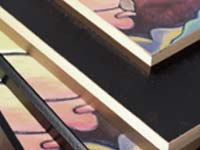 |
| Bezel In the context of Giclée printing and display, a bezel refers to the frame or border surrounding the viewing area of a digital screen or monitor. Bezels are commonly found on devices such as computer monitors, TVs, and digital photo frames, where they serve both aesthetic and functional purposes. Bezels can vary in size, material, and design, influencing the overall appearance and usability of the device. |
| Bit Depth Bit depth, also known as color depth, refers to the number of bits used to represent each pixel in a digital image. It determines the range of colors that can be reproduced in the image, with higher bit depths allowing for more shades and nuances of color. In Giclée printing, images with higher bit depths typically result in smoother gradients, better color accuracy, and finer detail reproduction, resulting in higher-quality prints with greater visual fidelity. |
| Black (cmyk) In the CMYK color model used in printing, black (K) is one of the four primary ink colors, along with cyan (C), magenta (M), and yellow (Y). Black ink is used to create rich, deep shadows and textural details in printed images, enhancing contrast and definition. By combining varying amounts of cyan, magenta, yellow, and black ink, printers can achieve a wide range of grayscale tones and reproduce images with greater detail and accuracy. |
| Black Point In digital imaging and printing, the black point refers to the darkest level of black that can be reproduced in an image or print. It represents the minimum intensity of black that the system or device is capable of producing. Maintaining a true black point is crucial for preserving shadow detail and contrast in printed images, ensuring that dark areas appear rich and well-defined without losing important visual information. |
| Bleed Printing Bleed printing is the process of printing an image or design with bleed, where the ink extends beyond the intended trim edge of the printed piece. This technique is often used in Giclée printing to produce full-bleed prints, where the image or design seamlessly extends to the edge of the paper without any white borders. Bleed printing requires careful setup and trimming to ensure that the final prints have clean, uniform edges and maintain the integrity of the design. |
Bond Paper Originally used in preparing government bonds, this type of paper is of high quality and quite durable, generally having a paper weight of more than 50 g/m². In the printing business, this paper is used to produce important documents, or may be used as a lower-cost option to light fine art papers, for producing artistic reproductions.
Bond paper may be used to create original artworks using pen, ink, or pencil, and is sometimes made from rag pulp, which creates a stronger paper with a distinct texture. |
| Borderless Printing Borderless printing is a printing method where the printed image extends all the way to the edges of the paper or substrate, without leaving any white borders. In Giclée printing, borderless printing is achieved by adjusting the printer settings to allow for full-bleed printing, ensuring that the image covers the entire printable area of the paper. This technique is commonly used to create prints with a seamless, edge-to-edge appearance, particularly for photographs, art prints, and other visually impactful designs where borders would detract from the overall presentation. |
Box frame An option for a dry mounting base; a wood board with a wood frame behind to achieve the look of an unframed canvas without the canvas. The result is a sturdy decorative piece with a matte or shine finish. A choice of depths is generally available.
Purchase box frame custom wood panels directly from our website. |
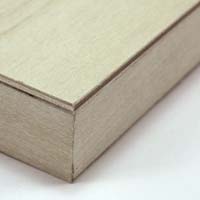 |
| Bristle Bristle refers to the stiff, coarse hairs or fibers used in traditional painting brushes. In Giclée printing, bristle textures can be digitally simulated or incorporated into the printing process to mimic the appearance and texture of brushstrokes in traditional artwork. Bristle textures add depth, dimension, and tactile quality to printed images, enhancing their realism and artistic appeal. |
| Bronze Bronze is a metallic alloy composed primarily of copper and tin, often used in sculpture and fine art. In the context of Giclée printing, bronze may refer to the reproduction of metallic textures or colors in printed artwork. Specialized printing techniques can simulate the appearance of bronze, incorporating metallic inks or finishes to create prints with a lustrous, metallic sheen reminiscent of bronze sculptures. |
| Butting Butting refers to the alignment of printed images or elements so that they meet or about each other without overlapping. In Giclée printing, precise butting is essential for creating seamless joins between adjacent printed panels or sections, particularly in large-format prints or multi-panel artworks. By ensuring accurate alignment and registration of printed elements, butting helps maintain the integrity and continuity of the printed image, resulting in a cohesive and professional-looking final product. |
C ^^Top
Canvas A heavy-duty, tightly woven fabric; rolls of specialty canvas are used in inkjet prints to produce Giclée canvas prints. After they are printed, the canvas is treated with a protective coating that guards against scratching, and dust and water damage.
Order online:
Mounted Artist Canvas
Rolled Artist Canvas |
 |
| Canvas Board Refers to canvases that are wrapped around a thin board instead of stretched over a wooden frame. These canvases are sturdy due to the backing, but are generally constructed from lower quality canvas fabric. They are easy to frame in a regular picture frame due to their thin depth. |
Canvas Floater A style of frame ideal for a gallery wrapped canvas print or original painting. This frame overlaps the artwork from behind (instead of in front like a traditional picture frame), where the wooden frame of the canvas is affixed to the floater frame. The floater frame surrounds the canvas, separated by a gap of approximately 1/4 inch on each side, creating a “floating” effect. Floater frames are available in a variety of styles, including “stair step”, “tapered” and “L shape”.
View our large collection of canvas floater frames. |
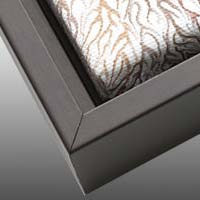 |
Canvas Pliers Used to stretch a canvas over and around a wooden stretcher bar frame. Once the canvas has been stapled to the back of one side of the frame, the next end of the canvas is held with the pliers and pulled tightly around the frame. While continuing to hold the canvas taut, staples are placed to affix the canvas to the frame.
Order online today: Canvas Pliers |
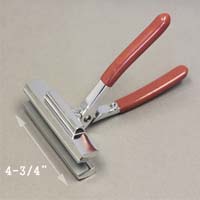 |
Canvas print A canvas print (also known as a stretched canvas) is an image printed onto canvas, generally with an inkjet printer, which is then stretched, framed and displayed.
Order your custom canvas print today. |
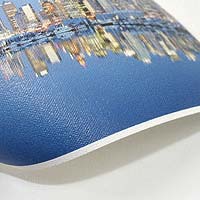 |
| Canvas Texture Canvas texture refers to the surface pattern or weave characteristic of canvas material used for painting or printing. In Giclée printing, canvas texture can be digitally replicated or physically added to the printing substrate to mimic the appearance and tactile feel of traditional canvas. The texture adds depth, dimension, and a sense of authenticity to printed artwork, particularly for reproductions of paintings or artworks originally created on canvas. |
Canvas transfer A process which lifts the image on a print off the paper support so that it can be transferred to a canvas mount.
Place an order online: Canvas Transfers |
| Card Stock Card stock is a type of thick, heavy-weight paper or paperboard commonly used in printing for applications requiring durability and stiffness. In Giclée printing, card stock may be used for producing high-quality prints of photographs, artwork, or marketing materials that demand a premium look and feel. Card stock comes in various weights, thicknesses, and finishes, making it suitable for a wide range of printing projects, including business cards, postcards, invitations, and greeting cards. |
| Center of Interest The center of interest, also known as the focal point or focal area, refers to the main subject or primary point of visual focus in a piece of artwork or photograph. In Giclée printing, the center of interest plays a crucial role in guiding the viewer's attention and conveying the intended message or narrative of the image. It is often strategically positioned or emphasized through composition, lighting, and contrast to draw viewers in and evoke emotional or intellectual responses. |
| Chain dot These dots of ink, otherwise called elliptical dots, which meet at the outer edges, creating a chain effect. The term may be used for any midtone ink dots that meet. |
Chop (1) Verb: To cut or slice in fluid, repetitive motion, generally wood, with a sharp, straight blade. A chopper is used to cut wood picture frame and stretcher bar moldings at 45 degree angles in preparation for assembly.
(2) Noun: an uncut length of picture frame moulding that is ready to be mitered and constructed. |
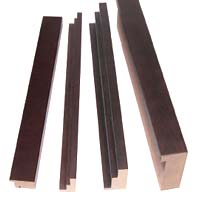 |
| Chop Mark The signature of the printer, applied to the prints produced in that workshop using a stamp or embossing. Much like the artist signs each piece. |
| Chopper The machine used to cut picture frame moldings and stretcher bar lengths. It may be controlled manually or by a motor. The knife blades of the chopper are angled at 45 degrees and meet at a point. The result is a 45 degree angle cut on both sides of the wood beam. |
| Chroma Chroma, also known as saturation or intensity, refers to the purity and vividness of a color in an image. In Giclée printing, chroma is controlled by adjusting the concentration or saturation of colorants used in the printing process. High chroma colors appear bold, vibrant, and rich in hue, while low chroma colors appear muted, subdued, or desaturated. Managing chroma levels is essential for achieving accurate color reproduction and maintaining the visual impact and fidelity of printed artwork or photographs. |
| ChromaLuxe ChromaLuxe is the world’s leading manufacturer of high definition sublimatable photo panels. Through dye sublimation, images are infused directly into specially coated sheets of metal, wood, and table top panels to create the most vibrant, durable, and longest lasting photo medium in the world. |
| Chrome Chrome refers to the strength of a color when compared to neutral gray. Another word for "saturation". |
| Chrominance Chrominance, often abbreviated as "C" in color spaces like YCbCr or YUV, refers to the color information or colorfulness of an image, independent of its brightness or luminance. In Giclée printing, chrominance plays a critical role in determining the overall color accuracy, saturation, and vibrancy of the printed output. Adjusting chrominance levels allows printers to control the intensity and purity of colors, ensuring that printed images accurately reproduce the intended hues and tones with fidelity and consistency. |
| Clamping A process of fastening two items together with a strong grip. Generally, a special tool called a clamp is used, which is tightened by twisting or pumping a lever until the required grip is achieved. In picture framing, clamps may be used to affix art temporarily to a board, or hold picture frame corners in place until an adhesive dries. |
| Clamps The tool used in fastening two items together with a strong grip. The tool is tightened by twisting or pumping a lever until the required grip is achieved. In picture framing, clamps may be used to affix art temporarily to a board, or hold picture frame corners in place until an adhesive dries. |
 |
| Climate control Climate control is important for preserving original and significant pieces of art. Changes in humidity and temperature can cause artwork to expand, warp, discolor or begin to flake. In addition to framing with high quality, archival-grade materials, climate control will protect the artwork for many generations. |
| CMYK A common color mode term used by graphic artists and print technicians. CMYK stands for Cyan, Magenta, Yellow, Black, and identifies the color cartridges commonly used in ink jet printers. |
Coated wire A hanging wire popular in picture framing that is covered in a clear or opaque plastic coating. Coating the wire gives it some additional strength, protects it from fraying and makes it safer to handle.
Order online:
Plastic-coated Wire |
| Cold lamination Lamination is a process of permanently applying a clear plastic coating to paper. In cold lamination, the cover's adhesive is activated by pressure rather than heat. It is a safe option when laminating heat-sensitive images (any image that could be negatively affected by the application of heat), primarily papers printed with inkjet printers. Cold lamination also provides better UV protection than hot lamination. |
Color Calibration The measurement or adjustment of the way a device responds to the colors input to its system. In fine art printing, it is important that the designer's monitor is calibrated corrected so as to display the digital image as close to its original digital capture as possible. It is significant to note, however, that in the case of a reproduction, the original digital scan or photograph will not be identical to the physical artwork in color saturation.
Read more about color matching in art reproduction. |
| Color Depth Color depth, also known as bit depth, refers to the number of bits used to represent each pixel in a digital image. It determines the range of colors that can be displayed or reproduced in the image, with higher color depths allowing for more shades and nuances of color. In Giclée printing, color depth directly impacts the quality and fidelity of printed images, with higher bit depths enabling smoother gradients, better color accuracy, and finer detail reproduction. Common color depths used in printing include 8-bit (256 colors), 16-bit (65,536 colors), and 24-bit (16.7 million colors). |
| Color Filter Array A color filter array (CFA) is a pattern of color filters placed over the individual pixels of an image sensor in digital cameras and scanners. The most common CFA arrangement is the Bayer filter, which uses alternating red, green, and blue filters to capture color information. In Giclée printing, the color filter array plays a crucial role in capturing accurate color data from the original artwork or photograph, which is then processed and reproduced using inkjet printing technology. |
| Color Harmony Color harmony refers to the pleasing arrangement or combination of colors in an artwork or design that creates a visually balanced and aesthetically pleasing result. It involves the careful selection and arrangement of colors based on principles such as complementary, analogous, or triadic color schemes, as well as considerations of hue, saturation, and value. In Giclée printing, achieving color harmony is essential for ensuring that printed images evoke the desired emotional or visual impact and maintain a sense of coherence and unity. |
| Color Management Color management is the process of controlling and maintaining consistent color reproduction throughout various stages of the digital imaging workflow, from image capture and editing to printing and display. It involves the use of standardized color spaces, color profiles, and calibration techniques to ensure accurate color representation across different devices and media. In Giclée printing, effective color management is crucial for achieving color accuracy, fidelity, and consistency in printed output, regardless of the printing equipment or materials used. |
| Color Management System A color management system (CMS) is a software-based solution or set of tools used to implement color management techniques and workflows in digital imaging and printing. It includes features such as color profiling, color space conversion, and device calibration to ensure consistent and accurate color reproduction across different devices, software applications, and output media. In Giclée printing, a color management system is essential for maintaining color accuracy and fidelity throughout the printing process, from image editing and proofing to final print production. |
| Color Picker A color picker is a graphical user interface tool used to select and choose colors from a color palette or spectrum. It typically allows users to interactively sample colors from an image or specify colors using numerical values for hue, saturation, and brightness. In Giclée printing, color pickers are commonly used in digital imaging software for adjusting color balance, applying color corrections, and selecting ink colors for printing, providing users with precise control over the color reproduction process. |
| Color Range Color range refers to the extent of colors that can be perceived or reproduced by a given device, medium, or color space. It encompasses the full spectrum of visible colors, including variations in hue, saturation, and brightness. In Giclée printing, the color range of the printing system, ink set, and substrate determines the range of colors that can be accurately reproduced in printed images. Printers strive to achieve wide color ranges to faithfully reproduce the rich hues and tones of the original artwork with precision and fidelity. |
| Color Rendering Index The color rendering index is a quantitative measure of a light source's ability to accurately reproduce the colors of objects compared to a natural or ideal light source. It is expressed as a numerical value ranging from 0 to 100, with higher values indicating better color rendering. In Giclée printing, color rendering index may be considered when evaluating lighting conditions for viewing prints, ensuring that colors are perceived accurately and consistently under different lighting environments. |
| Colorant A colorant is a substance or material that imparts color to another material or surface by absorbing or reflecting certain wavelengths of light. In Giclée printing, colorants are the inks or pigments used to create printed images on paper, canvas, or other substrates. Different types of colorants, such as dye-based or pigment-based inks, offer varying characteristics in terms of color accuracy, lightfastness, and durability, influencing the quality and longevity of printed output. |
| Colorimetry Colorimetry is the science and technology of measuring and quantifying colors based on their perceptual attributes, such as hue, saturation, and brightness. It involves the use of color measurement instruments and mathematical models to analyze and describe colors in terms of their spectral properties and human perception. In Giclée printing, colorimetry plays a crucial role in color management, color matching, and quality control processes to ensure accurate and consistent color reproduction in printed output. |
| Complementary Color Complementary colors are pairs of colors that are located opposite each other on the color wheel. When combined, complementary colors produce a neutral gray or white color, and when placed next to each other, they create strong visual contrast and enhance each other's intensity. In Giclée printing, understanding complementary colors is important for creating dynamic and visually striking color compositions, as well as for color correction and color grading purposes. |
| Complementary colours A pair of colors that produce black when combined (or in the case of colored light, white). Placed side by side, this pair creates the greatest possible contract between the colors. Complementary color pairs in the RGB model: red and cyan; yellow and blue; magenta and green. |
| Compression Artifact A compression artifact is a distortion or visual anomaly that occurs in digital images or video as a result of data compression techniques used to reduce file size. Common compression artifacts include blocky pixelation, blurring, ringing, or color banding, which can degrade image quality and reduce detail and clarity. In Giclée printing, avoiding compression artifacts is important when preparing digital images for printing to ensure that printed output retains high-quality, crisp detail, and accurate color reproduction. |
| Contact Print A contact print is a photographic print made by placing a negative or transparency directly in contact with photosensitive paper and exposing it to light. This results in a print where the size of the image matches that of the original negative or transparency, producing a one-to-one reproduction without enlargement. Contact prints are commonly used in traditional darkroom printing processes and are valued for their fidelity to the original image and fine detail reproduction. |
| Continuous Tone Continuous tone refers to an image that contains a smooth gradation of tones from light to dark without any abrupt transitions or visible dots or pixels. It is characteristic of analog photography and printing processes, where variations in exposure or ink density produce a seamless range of shades and hues. In Giclée printing, achieving continuous tone reproduction is essential for creating high-quality prints with lifelike detail and smooth tonal transitions. |
| Contrast Relative difference between the brightest and darkest parts of an image. A contrast control adjusts the peak white level of a display device. High contrast displays as a highly noticeable separation between the light and dark shades in the image. |
Cotton A soft fiber made from the cotton plant. It is highly versatile, and in picture framing is used in mat boards, fine art papers and canvas.
This white vegetable fiber grown in warmer climates in many parts of the world, has been used to produce many types of fabric for hundreds of years. Cotton fabric feels good against the skin regardless of the temperature or the humidity. |
 |
Cotton rag Paper made from 100% cotton fibre. Unlike most paper made from wood pulp, cotton rag paper is stronger, more durable, acid-free, and suitable for archival purposes.
Order online:
100% Cotton Matboard
Stretched Artist Canvas
Rolled Artist Canvas |
| Craze The fine cracks that appear along the surface of acrylic sheeting and within hardened varnish when too much pressure has been applied. |
| Curves Curves, also known as tone curves or contrast curves, are graphical representations of the tonal values in an image and the adjustments made to them. They allow users to adjust the brightness, contrast, and color balance of an image by manipulating the distribution of tones across the tonal range. In Giclée printing, curves are commonly used in image editing software to fine-tune the exposure, contrast, and color balance of prints, enabling precise control over the appearance and visual impact of the final output. |
| Cyanotype Cyanotype is a photographic printing process that produces cyan-blue prints using a light-sensitive iron-based solution. It involves coating a surface, such as paper or fabric, with a mixture of ferric ammonium citrate and potassium ferricyanide, then exposing it to ultraviolet light to create a chemical reaction that results in a blue image. Cyanotype printing is valued for its distinctive blue tones, simplicity, and versatility, and it is often used for artistic purposes and alternative photographic techniques. |
D ^^Top
D-max D-max, short for maximum density, refers to the darkest or maximum black value that can be achieved in a printed image. It represents the deepest shadow detail and the highest level of ink saturation that can be reproduced on a printing substrate. In Giclée printing, achieving a rich and dense D-max is important for enhancing contrast, depth, and visual impact in printed images, especially in areas with deep shadows or dark tones. High-quality printing substrates and ink formulations are often used to maximize D-max and ensure optimal print quality and longevity. |
| D-min D-min, short for minimum density, refers to the lightest or minimum density value in a printed image. It represents the areas of the print with the least amount of ink or toner deposited on the substrate, typically corresponding to highlights and lighter tones. Achieving a consistent and appropriate D-min is essential in Giclée printing to ensure that subtle details and highlights are accurately reproduced, maintaining overall image fidelity and tonal range. Ensuring an appropriate D-min is crucial as it establishes the baseline for the lightest tones in the printed image, contributing to overall tonal balance and image quality. |
| Desktop Printer A desktop printer is a compact and relatively inexpensive printing device designed for use on a desk or tabletop. Desktop printers are commonly used for personal or small-scale printing tasks, such as documents, photos, and artwork. In Giclée printing, desktop printers equipped with high-quality inkjet technology and archival-grade inks are often used by artists, photographers, and printmakers to produce small to medium-sized prints with professional-quality results, offering convenience, affordability, and versatility for printing fine art and photographic reproductions. Desktop printers offer users the flexibility to print directly from their computers or mobile devices, making them convenient tools for producing high-quality prints without the need for professional printing services. |
| Developer In traditional photography, a developer is a chemical solution used to process photographic film or paper, converting latent image particles into visible images. However, in the context of Giclée printing, the term "developer" typically refers to the software used to process digital images, adjust their properties, and prepare them for printing. This software allows users to fine-tune aspects such as color balance, exposure, contrast, and sharpness to optimize the appearance of the image before it is printed. |
Diasec Diasec is a registered trademark for a process used for face-mounting prints like photographs on acrylic sheets. The process was invented by Heinz Sovilla-Brulhart in 1969.
Because of the different light penetration and refraction of acrylic compared to normal glass, the colours are more brilliant and the image sharper than compared to standard glass in a picture frame. A Diasec mount is usually of a high gloss finish. Because the print is glued to the acrylic glass, the result is a completely flat mount of the image.
Process
The process aims to mount the print without air bubbles or smears. The image is face mounted and bonded to the acrylic glass with a gel silicone sealant which acts as a glue.
Normally the print is placed on a carrier at the backside. This is usually dibond, a composite plate of aluminium and plastic. Aluminium or other materials are also possible. If the print has to be backlit, translucent materials are necessary. |
| Digital Image A digital image is a visual representation of an object, scene, or artwork that is captured, created, or stored in digital form. It consists of a grid of pixels, each containing color or grayscale information, arranged to form a two-dimensional picture. Digital images can be created using digital cameras, scanners, or computer graphics software and stored as digital files in various formats. They can be displayed on electronic devices, shared online, or printed using Giclée printing technology, offering versatility and flexibility for artistic expression and communication. |
| Digital Printing Digital printing refers to methods of printing from a digital-based image directly to a variety of media. It usually refers to professional printing where small-run jobs from desktop publishing and other digital sources are printed using large-format and/or high-volume laser or inkjet printers. Digital printing has a higher cost per page than more traditional offset printing methods, but this price is usually offset by avoiding the cost of all the technical steps required to make printing plates. It also allows for on-demand printing, short turnaround time, and even a modification of the image used for each impression. |
| Digital Watermark A digital watermark is a hidden or visible marker embedded in a digital image to indicate ownership, authenticity, or copyright information. It is typically added during the image editing or printing process and can take the form of text, logos, patterns, or cryptographic codes. Digital watermarks help protect the intellectual property rights of artists and photographers by deterring unauthorized use, reproduction, or distribution of their images. In Giclée printing, digital watermarks can be incorporated into printed images to provide traceability and authentication, ensuring that prints are genuine and authorized. |
| Diorama A diorama is a three-dimensional model or display that depicts a scene or landscape in miniature scale, often enclosed within a box or frame. Dioramas are commonly used in art, education, and entertainment to recreate historical events, natural environments, or fictional worlds with intricate detail and realism. In Giclée printing, dioramas can be photographed or digitally reproduced to create high-quality prints that preserve the depth, texture, and perspective of the original three-dimensional artwork. |
| Dots per inch (dpi) Dots per inch (DPI) is a measurement used to describe the resolution of a digital image or the output resolution of a printing device. It represents the number of ink dots or pixels that can be printed or displayed within one linear inch of space. Higher DPI values indicate greater image detail and smoother tonal transitions, while lower DPI values result in coarser detail and visible pixilation. In Giclée printing, selecting the appropriate DPI setting is crucial for achieving sharp, high-quality prints with accurate color reproduction and fine detail. |
Double primed canvas Canvas treated with two coats of lead paint, which acts as as a barrier to prevent the artist's paint from soaking into the fabric. Double primed canvas generally has a smoother surface and is stiffer. However, due to this stiffness, it can crack along the edges when stretched.
At KeenART media, the canvas we print on is specially treated for Giclée printing.
We also offer unprimed and double-primed artist canvas for sale. |
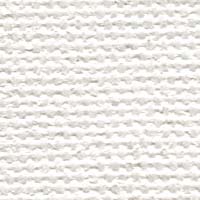 |
| DPI DPI is a printing term that describes the number of dots per inch that are used to create an image. The higher the DPI, the higher the quality of the image. 300 DPI is sufficient for most applications. We recommend a higher DPI if you plan on resizing your images to a size larger than the original photos. |
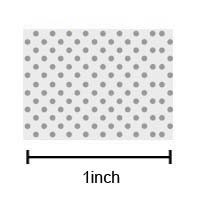 |
| Droplet Size Droplet size refers to the size of individual ink droplets ejected from the printhead of a printing device during the printing process. In inkjet printing, droplet size affects the resolution, sharpness, and color accuracy of printed images. Smaller droplets produce finer details and smoother gradients, while larger droplets may result in more visible ink dots and coarser texture. Printers with variable droplet size technology can achieve a wider range of tones and textures, allowing for high-quality Giclée prints with precise control over ink deposition and image reproduction. |
Dry Mount Press The machine used for dry mounting a print. The print, adhesive and backing board are laid on the flat surface of the press and pressed tightly between the lid and the base. The machine activates the adhesive using heat, which affixes the print to the backing.
We offer dry mounting services. Order online today! |
Dry Mounting The use of a heat-activated adhesive to affix a paper print to a hard surface, such as foam core, Gatorboard or Dibond (a thin, aluminum sheet).
We offer dry mounting services on various substrates. |
| Drying Time Drying time is the amount of time required for printed images or ink layers to dry completely on the printing substrate after being ejected from the printer. In Giclée printing, drying time varies depending on factors such as ink type, substrate material, environmental conditions, and printing settings. Proper drying is essential for ensuring that prints are smudge-resistant, durable, and ready for handling and display. Fast-drying inks and optimized printing conditions can help minimize drying time and improve workflow efficiency in Giclée printing. |
| Duck canvas A tightly woven, heavy, plain-weave, bottom-weight fabric with a hard, durable finish. The fabric is usually made of cotton. |
Dye Sublimation Sublimation is a process where an image can be printed onto transfer paper using dye-based inks and then with heat and pressure become transferred into the substrate.
Dye sublimation on hard surface surfaces is possible if the surfaces have been coated. Instead of printing images directly on a surface, which may scratch easily, the image is infused into the coating to provide permanent protection and durability.
|
| Dye-Based Inks Dye-based inks are liquid colorants composed of soluble dyes dissolved in a carrier liquid, such as water or glycol. These inks are commonly used in inkjet printers for their vibrant colors, wide color gamut, and smooth color transitions. Dye-based inks are known for producing prints with high color saturation and excellent image quality, particularly on glossy or coated papers. However, they may be less resistant to fading and moisture compared to pigment-based inks, making them more suitable for indoor use and short-term applications in Giclée printing. |
| Dye-Sublimation Printer A dye-sublimation printer is a type of digital printing device that uses heat to transfer dye directly onto a substrate, such as paper, fabric, or plastic. The process involves printing the image onto a special transfer paper using dye-sublimation inks, then applying heat and pressure to transfer the dye onto the substrate, where it sublimates and bonds with the surface. Dye-sublimation printers are commonly used for producing high-quality, durable prints with continuous-tone images, vibrant colors, and smooth gradients, making them popular for applications such as photo printing, textile printing, and product decoration in Giclée printing. |
E ^^Top
Eco-Solvent Inks An alternative to regular solvent inks that are much less toxic. This quality is beneficial because it allows the inks to be used in smaller print shops without extensive ventilation.
Solvent Ink:
An ink formulated for inkjet printers, ideal for printing directly to vinyl and other plastics. The corrosive nature of the compounds "eat" into the surface of the substrate, securing the pigment or dye.
As a result, solvent inks are waterproof, scratch resistant, and fade proof, perfect for outdoor signage and billboard displays.
Solvent ink can also refer to any type of printer ink that is not water-based.
|
| Edge Sharpness Edge sharpness refers to the clarity and definition of edges in a printed image, particularly in areas of high contrast or fine detail. It is influenced by factors such as printer resolution, image resolution, ink droplet size, and substrate texture. Achieving optimal edge sharpness is essential for producing prints with crisp detail, smooth transitions, and accurate reproduction of fine lines and text in Giclée printing. Proper image processing, printer calibration, and substrate selection can help improve edge sharpness and enhance overall print quality. |
| Enlargement An enlargement refers to a printed image that has been reproduced at a larger size than its original dimensions. It involves scaling up the image to create a larger print while maintaining its aspect ratio and visual quality. Enlargements are commonly produced in Giclée printing by using high-resolution digital files or enlarging photographic negatives or transparencies during the printing process. Enlargements are often used in fine art, photography, and commercial printing to showcase detailed artwork, photographs, or graphics on a larger scale. |
| Enlarger An enlarger is a device used in traditional darkroom photography to project and focus an image from a negative or transparency onto photosensitive paper for printing. It consists of a light source, a negative carrier, a lens system, and an adjustable height mechanism to control the size and focus of the projected image. Enlargers allow photographers and printmakers to produce prints of various sizes by adjusting the magnification and exposure settings during the printing process. Although less common in the digital age, enlargers are still used by some photographers and artists for producing analog prints and alternative printing techniques. |
Epoxy resin A clear, viscous coating made from synthetic polymers that is applied to a surface. The resin hardens into a shiny, glass-like coating. Many epoxy resins are self-levelling, which means a flat surface will form without manually spreading the liquid.
Order Online: Epoxy Resin Ex-74
Learn more about our variety of resin coating services.
Read more in our article: Epoxy Resin Coatings |
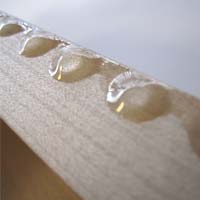 |
EX-74 Resin A liquid coating that, when applied to a flat surface, will harden into a clear, high gloss, protective cover that is resistant to fading and discoloration caused by UV exposure. It is waterproof and heat-resistant once set.
Order Online: Epoxy Resin Ex-74
Read more: Epoxy Resin Coatings |
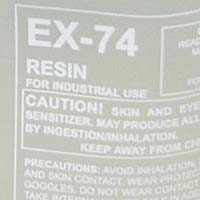 |
| EXIF Besides information about the pixels of the image, most cameras store additional information such as the date and time the image was taken, aperture, shutterspeed, ISO, and other camera settings. |
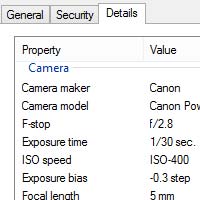 |
Exposure Compensation Exposure compensation is a camera setting that allows photographers to manually adjust the exposure settings to achieve the desired brightness or darkness in a photograph. It is typically expressed in terms of exposure value (EV) increments, with positive values indicating increased brightness (overexposure) and negative values indicating decreased brightness (underexposure).
Exposure compensation is useful in situations where the camera's automatic exposure metering may not accurately capture the desired exposure, such as high-contrast scenes or backlit subjects. In Giclée printing, exposure compensation may also be applied during the image editing process to fine-tune the exposure and optimize print quality. |
| Exposure Value (EV) Exposure Value (EV) is a numerical scale that represents a combination of aperture and shutter speed settings used to achieve a specific exposure level in photography. It provides a standardized way to measure and compare different combinations of aperture and shutter speed settings. Each increment on the EV scale represents a doubling or halving of the amount of light reaching the camera sensor or film. Photographers use EV to adjust exposure settings to compensate for changes in lighting conditions or achieve creative effects while maintaining consistent exposure levels. |
F ^^Top
F-stop F-stop, also known as f-number or aperture value, is a numerical measurement that indicates the size of the aperture opening in a camera lens. It represents the ratio of the lens's focal length to the diameter of the aperture opening. Lower f-stop values indicate larger aperture openings, which allow more light to pass through the lens and reach the camera sensor or film, resulting in brighter exposures and shallower depth of field. Higher f-stop values indicate smaller aperture openings, which reduce the amount of light and increase depth of field. F-stop settings control exposure, depth of field, and image sharpness in photography. |
| Face-mounted Face-mounting is a process used in fine art printing and display where a print is adhered to the back of a transparent material, such as acrylic or glass, using a clear adhesive. This creates a smooth, glossy surface on the front of the print, enhancing its visual impact, depth, and vibrancy. Face-mounted prints are valued for their modern and sleek appearance, as well as their durability and resistance to fading, moisture, and damage. Face-mounting is commonly used for displaying Giclée prints, photographs, and artwork in galleries, exhibitions, and commercial settings. |
| Fade(ing) To lose or cause to lose brightness or brilliance or definition of line, form and color. |
Fading Fading refers to the gradual loss or alteration of colors, tones, or image detail in a printed or displayed image over time due to exposure to light, heat, humidity, pollutants, or other environmental factors. Fading can occur in both analog and digital prints, affecting the visual quality and longevity of the printed image.
Factors such as ink type, paper quality, display conditions, and protective coatings can influence the rate and severity of fading. To minimize fading in Giclée printing, archival-quality materials, pigment-based inks, UV-resistant coatings, and proper display techniques are often used to ensure long-lasting print durability and color stability. |
Fast Color Ink This term refers to inks that are "color fast", meaning they retain the density of their color and do not fade despite washing and excessive handling.
Depending on the ink, color fast may imply UV fade-resistant |
| Feathering Feathering, also known as softening or blending, is a digital image editing technique used to create smooth and seamless transitions between adjacent areas of an image. It involves selectively blurring or blending the edges of a selection or mask to reduce or eliminate harsh transitions and create a more natural and aesthetically pleasing effect. Feathering is commonly used in techniques such as image compositing, retouching, and selective adjustments to blend elements together seamlessly and achieve professional-looking results in Giclée printing and digital photography. |
| Felt Marker A felt marker, also known as a felt-tip pen or marker pen, is a writing or drawing tool with a porous tip made of compressed felt or fiber material. Felt markers are commonly used for creating bold, expressive lines and vibrant colors on various surfaces, including paper, cardboard, plastic, and fabric. They come in a wide range of colors, tip sizes, and ink formulations, making them versatile tools for sketching, coloring, lettering, and illustration. In Giclée printing, felt markers may be used for hand-drawn artwork or annotations on printed images before scanning or digitization. |
Fiber Paper Used in the creation of photographic prints, fiber-based papers are coated with a substance called baryta (a mixture of barium sulfate and strontium). This treatment brightens the paper, or tints may be added to subtle color. Fiber paper usually has a gelatin layer as well, which protects the paper during processing. Most often, these kinds of paper are used when the photographer requires high-quality, long lasting prints for exhibition or sale.
Fiber-based papers are also available for digital printing, considered ideal for producing beautiful black and white photographic images with excellent grey tones. Baryta is added to the ink-receptive coating in order to achieve the same effect as traditional papers. |
Filter In photography, a filter is an optical accessory that is placed in front of the camera lens to modify or enhance the appearance of the image by altering the color, contrast, or light transmission properties of the incoming light. Filters can be made of glass, plastic, or gelatin and come in various types, such as color filters, neutral density filters, polarizing filters, and special effects filters.
Each type of filter serves a specific purpose, such as correcting color temperature, reducing glare, intensifying colors, or creating artistic effects. Filters are commonly used in landscape photography, portrait photography, and studio photography to achieve desired visual effects and creative interpretations in Giclée printing. |
| Fine art Any of the visual arts, including painting, drawing, printmaking, sculpture and some performance art. The term generally excludes other art forms such as poetry, literature, dance and music. |
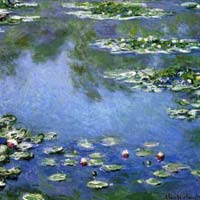 |
Fine Art Paper Fine art paper, also known as art paper or archival paper, is a high-quality paper substrate specifically designed for printing fine art reproductions, photographs, and digital artwork. It is characterized by its excellent print quality, longevity, and ability to reproduce rich, vibrant colors and intricate details with exceptional clarity and precision.
Fine art papers come in a variety of textures, weights, finishes, and compositions, including cotton rag, alpha cellulose, and specialty papers such as matte, glossy, satin, and textured surfaces. Fine art papers are commonly used in Giclée printing for producing museum-quality prints that meet the highest standards of durability, aesthetics, and archival preservation. |
Fine Art Papers There is a huge variety of fine art papers available for digital printing. Much like fabrics, they vary depending on their intended application and the printer/ink that will be used to produce them. These papers will almost always be archival or conservation quality, which means they are free from acid, chlorine, and lignin (a natural polymer found in wood that causes deterioration), and buffered to achieve a neutral pH prior to being coating for the printer.
Fine art paper is generally 100% cotton, though cotton blends do exist. It is available in many different surface textures from smooth to as rough as watercolor paper, and finishes such as matte, satin, and gloss. The color of the paper will also vary by material and manufacturer, from a cool blue-white to a soft, almost off-white.
Order online: Fine Art Prints |
Fine Art Photography Fine art photography refers to a genre of photography that emphasizes creative expression, aesthetic quality, and artistic vision, rather than simply documenting subjects or events. Fine art photographers use photography as a medium for self-expression, exploration of concepts, and communication of ideas, often employing techniques such as composition, lighting, framing, and post-processing to create visually compelling and emotionally resonant images.
Fine art photography encompasses a wide range of subjects, styles, and approaches, including landscapes, portraits, still life's, abstracts, and conceptual art. Prints of fine art photographs are commonly produced using high-quality materials and printing techniques, such as Giclée printing, to preserve the integrity and artistic intent of the original images. |
Fine Art Reproduction The process of photographing or scanning original artworks and digitally color matching them, and then printing copies with a high quality - usually giclée - printer on conservation-grade (archival) paper or canvas.
We offer high quality fine art print reproductions of your favorite artwork. |
| Finger-jointed Refers to the way pieces of molding and stretcher bar wood are connected. Shorter pieces joined by thin, interlocking teeth will produce a straighter, stronger length than a long, complete beam of wood. This method also reduces the waste of smaller wood pieces. |
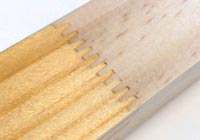 |
| Finishing The final processes in preparing a fine art print or wrapped canvas for display. This may include fitting the artwork into the frame, attaching hanging hardware and affixing dust covers or cloth tape to the back of the frame. |
| Fixative A fixative is a chemical solution applied to a finished artwork or print to protect the surface, prevent smudging, and enhance durability. Fixatives are commonly used in traditional drawing, painting, and printmaking techniques to seal and stabilize the media, such as charcoal, pastels, graphite, and ink, and prevent them from smudging or rubbing off. Fixatives come in various formulations, including aerosol sprays, brush-on liquids, and archival varnishes, each offering different levels of protection and compatibility with different media and substrates. In Giclée printing, fixatives may be applied to printed images on paper or canvas to enhance longevity, resistance to handling, and overall print quality. |
| Flare Flare refers to unwanted stray light that enters the camera lens and causes glare, haze, or reduced contrast in a photograph. Flare can occur when bright light sources, such as the sun or artificial lights, shine directly into the lens or bounce off reflective surfaces, such as glass or water. Flare can manifest as ghosting, veiling glare, or lens flare artifacts, depending on the angle, intensity, and position of the light source relative to the camera lens. To minimize flare in photography, photographers may use lens hoods, lens filters, or shading techniques to block stray light and improve image contrast and clarity. In Giclée printing, flare artifacts may be visible in printed images if not properly corrected during the image editing or printing process. |
| Flash Memory Card A flash memory card is a solid-state storage device used for storing digital data, such as photographs, videos, music, and documents. Flash memory cards use non-volatile memory chips to store data, allowing for fast read and write speeds, high reliability, and compact form factors. Common types of flash memory cards include Secure Digital (SD), CompactFlash (CF), microSD, and Memory Stick, each offering different storage capacities and transfer speeds. Flash memory cards are commonly used in digital cameras, camcorders, smartphones, tablets, and other electronic devices for storing and transferring digital media files. |
| Flash Sync Flash sync, also known as flash synchronization, refers to the coordination of a camera's shutter speed with the firing of an external flash unit to ensure proper exposure and synchronization of flash and ambient light. Flash sync is important for preventing motion blur and achieving consistent lighting in flash photography, particularly when using high-speed flash units or capturing fast-moving subjects. Different cameras have specific flash sync speeds, typically ranging from 1/60 to 1/250 of a second, which represent the maximum shutter speed at which the entire image sensor is exposed while the flash fires. |
| Flatbed Printer A printer, generally wide-format, that can print directly onto rigid materials. Instead of passing a roll of substrate through, the flat material is placed on a bed or table equipped with rollers, which feed it beneath a sliding print head. |
Flatbed Scanner A flatbed scanner is a type of image scanner that uses a flat, glass surface to capture digital images of flat objects, such as photographs, documents, artwork, and other two-dimensional materials. Flatbed scanners typically consist of a scanning bed, a scanning head with a light source and sensors, and scanning software for controlling scanning parameters and capturing images.
Users place the object to be scanned face-down on the scanning bed, close the scanner lid to ensure even illumination and focus, then initiate the scanning process using the scanning software. Flatbed scanners are commonly used in offices, homes, and professional settings for digitizing and archiving documents, photos, and artwork with high-quality results. |
| Float(ing) A means of securing artwork to a rigid support so that all edges are visible. |
Floater Frame (also called a "Canvas Floater") A style of frame ideal for a gallery wrapped canvas print or original painting. This frame overlaps the artwork from behind (instead of in front like a traditional picture frame), where the wooden frame of the canvas is affixed to the floater frame. The floater frame surrounds the canvas, separated by a gap of approximately 1/4 inch on each side, creating a “floating” effect. Floater frames are available in a variety of styles, including “stair step”, “tapered” and “L shape”.
Order online: Canvas Floater Frames. |
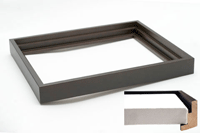 |
| Foreground In photography and visual arts, the foreground refers to the area of the composition that appears closest to the viewer or camera lens, typically occupying the lower portion of the image or scene. The foreground serves as a visual anchor or frame for the composition, providing context, depth, and scale to the overall image. Elements in the foreground often include prominent objects, subjects, or details that are intended to draw the viewer's attention and create a sense of depth and perspective. By carefully composing the foreground with other elements in the scene, photographers and artists can create visually compelling and dynamic compositions in Giclée printing. |
G ^^Top
Gallery wrap Gallery wrapping is the method of stretching an artist's canvas so that the canvas wraps around the sides of a wooden frame (called stretcher bars or strainer bars), and securing it to the back.The result is that the hardware (staples or tacks) used for securing the canvas is not visible from the front or sides.
The sides of the canvas are prepared and primed in the same manner as the face. They may be painted a solid color, or painted to continue the image appearing on the face. This method of stretching and preparing a canvas allows for a frameless presentation of the finished painting.
In canvas printing, the term “gallery wrap” refers to an image that appears on the sides of the frame as well as the front. The image on the sides is either a continuation or a reflection of the main image.
Order your gallery wrapped canvas print online today! |
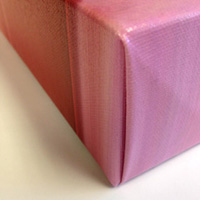 |
| Gamma Correction Gamma correction is a technique used to adjust the brightness and contrast of digital images to ensure consistent and accurate representation on different display devices. It involves applying a nonlinear adjustment to the pixel values in an image to compensate for the nonlinear response of display devices, such as monitors and printers. Gamma correction helps to maintain the perceptual uniformity of images across different viewing conditions and devices, ensuring that images appear correctly exposed and visually balanced. |
| Gamut Mapping Gamut mapping is a color management process used to adjust or transform the color gamut of an image to match the color reproduction capabilities of a particular output device or color space. It involves mapping colors from one color gamut to another while preserving the overall appearance and visual intent of the original image. Gamut mapping algorithms analyze the color gamut of the source and target devices, then adjust the colors in the image to ensure accurate and consistent color reproduction across different output devices, such as monitors, printers, and digital projectors. |
Gatorboard A panel composed of a thin sheet of dense foam sandwiched between several layers of thick paper. The result is an extremely rigid and durable base for dry mounting fine art prints and photographs, and lamination.
Order online:
3/16 inch Gatorboard
1/2 inch Gatorboard |
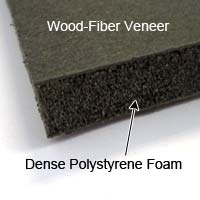 |
Gel Medium Also called acrylic gel medium.
A thick, usually transparent substance that is used to alter the consistency or appearance of acrylic paints. Depending on the type used, a gel medium can add or reduce gloss, adhere mixed media or extend the amount of paint.
Gel medium is available in matte, gloss and semi-gloss and some are self-levelling (when poured, create a smooth surface without manual smoothing).
When used on their own, gel medium creates a textured surface on canvas prints that dries clear, effectively enhancing brush strokes and highlighting portions of the art where the application is thicker. |
Gesso A chalk-based paint mixture that is used to create texture on canvas surfaces prior to, or in lieu of, painting. Due to its absorbency, it can serve as a base for most types of paint.
Modern acrylic "Gesso" is actually a combination of Calcium Carbonate with an acrylic polymer medium latex, a pigment and other chemicals that ensure flexibility, and ensure long archival life.
It is also used as a base on sculptural work, wall paintings and wood panelling, or for priming blank canvas prior to oil painting. |
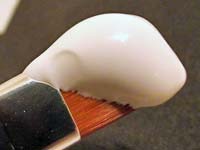 |
Giclée (gee-clay) A digital fine art print made with an inkjet printer. The term is derived from the French gicler (to spray), and refers to the spraying of ink from an inkjet printer onto the printed surface. The earliest giclées were made using Iris printers, which sprayed microscopic drops of color onto a fine art paper or canvas. Capable of displaying the full color spectrum, these artworks have vibrant, brilliant colors, and a velvety texture. This gives the finished product the look and texture of an original painting.
Browse our selection of Giclée canvas prints, and order yours today. |
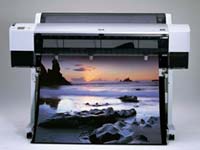 |
| Giclée Printmaker A Giclée printmaker is an individual or company specializing in the production of Giclée prints using high-quality inkjet printing technology and archival materials. Giclée printmakers work closely with artists, photographers, and designers to reproduce their original artwork or digital files as fine art prints with exceptional color fidelity, detail, and longevity. Giclée printmakers use professional-grade inkjet printers, archival-quality inks, and premium substrates to ensure that prints meet the highest standards of quality and durability, suitable for display in galleries, museums, and private collections. |
| Giclée Reproduction A Giclée reproduction refers to a fine art print produced using the Giclée printing process to reproduce an original artwork, photograph, or digital image with exceptional color accuracy and detail. Giclée reproductions are commonly used by artists, photographers, and printmakers to create high-quality prints of their original works for distribution, sale, or exhibition. Giclée reproductions preserve the integrity and visual quality of the original artwork, capturing fine details, subtle color variations, and texture with precision and fidelity. They are often produced in limited editions and signed by the artist to enhance their collectability and value. |
| Giclée Varnish Giclée varnish is a protective coating applied to Giclée prints to enhance their durability, longevity, and appearance. It is typically a clear, transparent liquid coating that is sprayed or brushed onto the surface of the print after printing and drying. Giclée varnish helps to protect prints from moisture, UV light, fading, scratches, and abrasion, extending their lifespan and preserving their color accuracy and vibrancy. Varnishes come in various formulations, including matte, satin, and glossy finishes, each offering different levels of sheen and texture. |
| Giclee Giclée (pronounced zhee-klay) is a digital printing process that uses high-quality inkjet printers and archival-quality inks to produce fine art prints with exceptional color accuracy, detail, and longevity. The term "giclée" is derived from the French word "gicler," meaning "to spray," referring to the inkjet printing process used to create prints. Giclée printing is widely used in the reproduction of fine art, photography, and digital artwork, offering artists and printmakers a versatile and high-quality printing solution for producing museum-quality prints on a variety of substrates, including paper, canvas, and specialty media. |
Glazing (1) A technique of applying oil or acrylic color in thin, transparent layers so that the color beneath shows through, modifying the color of the glaze.
(2) The clear cover placed over an artwork within a frame; this may be plastic, plexiglass or real glass. |
| Gloss Finish A gloss finish is a type of surface coating that produces a shiny, reflective appearance on printed materials, such as photographs, artwork, and documents. Gloss finishes are achieved by applying a clear, glossy coating, such as varnish or laminate, to the surface of the printed material. Gloss finishes enhance the vibrancy, contrast, and depth of colors, making images appear more vivid and eye-catching. Gloss finishes are commonly used in Giclée printing to enhance the visual impact and aesthetic appeal of fine art prints, photographs, and reproductions. |
| Glossy Finish A high shine finish like that found on traditional photographic prints and resin-coated surfaces. The high degree of reflect creates very vibrant colors, but can obscure the image in certain lighting. |
| Graphic Design Graphic design is a creative discipline that involves the visual communication and presentation of ideas, concepts, information, and messages through the use of typography, imagery, color, and layout. Graphic designers use a combination of artistic skills, technical expertise, and creative problem-solving to create visual solutions for a wide range of applications, including branding, advertising, packaging, publications, digital media, and web design. Graphic design encompasses various specialties, such as logo design, illustration, typography, layout design, and digital imaging, and relies on both traditional and digital tools and techniques to create effective and visually compelling designs. |
| Grayscale Grayscale refers to an image that consists solely of shades of gray, ranging from black to white, without any color information. Grayscale images are created by representing each pixel in the image with a single value that corresponds to its brightness or luminance level. Higher pixel values represent lighter shades of gray, while lower pixel values represent darker shades of gray. Grayscale images are commonly used in photography, digital imaging, and printing to represent black-and-white photographs, illustrations, and text documents. Grayscale printing techniques, such as Giclée printing, allow for the accurate reproduction of grayscale images with smooth tonal transitions and fine detail. |
| Gridwall panels A metal grid that can be hung on a wall and used for displaying goods. |
| Grommet A grommet is a small metal or plastic ring inserted into a hole in a material, such as fabric, paper, or vinyl, to reinforce the hole or provide a means for attaching or securing the material. Grommets are commonly used in various applications, including banners, signs, tents, curtains, and clothing, where they serve to prevent tearing or fraying of the material around the hole and facilitate the attachment of ropes, cords, or fasteners for hanging, lacing, or securing purposes. |
| Gsm Grams per square meter. A metric measurement of paper density or "weight". |
| Gum Bichromate: Gum bichromate, also known as gum printing, is an alternative photographic printing process that dates back to the 19th century. It involves coating a paper or other substrate with a light-sensitive solution made from gum arabic and potassium dichromate, then exposing the coated surface to ultraviolet light through a negative or transparency. After exposure, the print is developed in water, which dissolves the unexposed areas of the coating, leaving behind a pigmented image. Gum bichromate prints are characterized by their soft, painterly appearance and tonal richness, as well as their potential for experimentation and creative expression. |
H ^^Top
Halation Halation is an optical phenomenon that occurs in photography when light passing through a transparent or translucent subject is scattered or reflected within the camera system, causing a halo or glow around bright areas in the resulting image. Halation is most commonly observed in backlit scenes or when photographing bright light sources, such as the sun or artificial lights. In traditional film photography, halation was often considered a technical flaw and was mitigated by using anti-halation backings on film or post-processing techniques. However, in certain artistic contexts, halation can be intentionally used for creative effect to enhance the mood or atmosphere of an image. |
| Hand Coloring Hand coloring, also known as hand-tinting or hand-painting, is a photographic or artistic technique where a black-and-white photograph or print is selectively colored or painted by hand using transparent or opaque pigments. Hand coloring dates back to the early days of photography when photographers would enhance their black-and-white prints with watercolors, dyes, or oil paints to add color and realism to the image. Today, hand coloring is still practiced by artists and photographers as a creative and expressive way to add color, depth, and emotion to their images, resulting in unique and personalized works of art. |
| Hard Proof A hard proof is a physical print produced as a proof or sample to evaluate the color accuracy, image quality, and layout of a digital file before final printing. Hard proofs are typically produced using the same printing process and materials that will be used for the final production run, allowing for a realistic representation of how the final printed piece will look. Hard proofs are used in various industries, including printing, publishing, graphic design, and photography, to ensure that the final printed output meets the desired specifications and quality standards. |
Hardware The varying collection of screws, offset clips, wire, hooks and hangers the customer will receive with which to prepare their finished artwork for hanging, and affix it to the wall.
Order online today: Framing Hardware |
| Haze Haze in photography refers to a lack of contrast and clarity in an image, resulting in a veil-like or foggy appearance that obscures details and reduces overall visual impact. Haze can be caused by various factors, including atmospheric conditions (such as humidity or pollution), lens flare, glare, or insufficient lighting. In post-processing, haze can also occur due to overexposure or improper image adjustments. Techniques such as adjusting contrast, clarity, and exposure, as well as using dehazing filters or adjustments, can help reduce haze and improve the clarity and contrast of the image. |
Heat presses A machine designed to press and apply heat to paper inserted between its surfaces. Used in lamination, to set or cure certain inks, or for applying heat-sensitive paper images to fabric or other material.
Have your favourite image immortalized with a dry mount. We offer a variety of heat press services. |
High-Resolution Image High-resolution = high quality.
If an image is high-resolution, this implies it will print well at a large - or at least the desired - size, with clear, crisp detail and no pixelation.
There is no single determination of high resolution. The size of the digital image must be comparable to the desired print size, but the quality must be good as well. For instance, a high ppi or dpi (pixels or dots per inch) but a small image (300x300 pixels) will not print well at any size.
However, a large size (3000x3000 pixels) and good dpi (300) does not guarantee quality either - the image could simply have been changed to these quantities with no regard for image quality, resulting in heavily pixelation (clusters of visible squares instead of a smooth image).
Ideally, the customer should confirm with the designer that their image is the appropriate resolution or quality for the print size. |
High-Resolution Scan A good quality digital image created from copying the artwork using a flatbed scanner. This is achieved by scanning the entire image at one time, or ensuring even light distribution when scanning multiple sections.
We can create a high-resolution digital images from any original artwork. View our artwork scanning services and place your order today. |
| Highlight Detail Highlight detail refers to the level of detail present in the brightest areas of an image, particularly in highlight regions where light is reflected or emitted at its highest intensity. Maintaining detail in highlights is important for preserving texture, structure, and tonal variation in bright areas of the image. Overexposure or clipping of highlights can result in loss of detail, causing highlights to appear washed out or lacking in texture. Techniques such as exposure adjustment, highlight recovery, and careful exposure metering can help preserve highlight detail in photography. |
| Highlights and Shadows Highlights and shadows are the two primary components of contrast in an image, representing the brightest and darkest areas, respectively. Highlights are the areas where light is reflected or emitted at its highest intensity, while shadows are the areas where light is blocked or absorbed, resulting in reduced illumination. The interplay between highlights and shadows creates depth, dimension, and visual interest in an image, defining the shape, form, and texture of objects. Properly balancing highlights and shadows is essential for achieving a well-exposed and visually appealing image with a full range of tonal values. |
| Hinge Mounting Hinge mounting is a method of mounting artworks or prints for display or framing using hinges attached to the back of the artwork and a mat or backing board. Hinge mounting allows the artwork to be secured in place without directly adhering it to the mounting surface, providing flexibility and protection against damage. The hinges are typically made of archival-quality materials, such as Japanese paper or linen tape, and are attached to the back of the artwork using archival adhesive or paste. Hinge mounting is commonly used for mounting delicate or valuable artworks, prints, photographs, and documents for display or preservation. |
| Hinging The process of adhering artwork to a backing or mounting board. Acid-free tape is attached to the top of the work and another strip is placed over the top to secure it on both surfaces. Try to hinge only from the top so the artwork is able to hang freely. This helps prevent the piece from buckling, as it enables the different components — artwork, frame, mat, mounting board, etc. — to expand and contract at their own rates with the temperature and humidity. |
Hot lamination Lamination is a process of permanently applying a clear plastic coating to paper. In hot lamination, the cover\'s adhesive is activated by heat. When inserted into the laminator, the clear cover is melted onto and around the paper, completely enclosing it in a protective casing. Hot lamination produces a product more resistant to wear and tear than cold lamination.
We offer three types of large format lamination as part of our dry mounting service. |
| Hue A color or shade. For example: Blue, grey, maroon. |
Hue Shift Hue shift, also known as color shift, refers to a change in the perceived color of an object or image due to alterations in lighting conditions, color reproduction, or color management. Hue shift can occur when viewing an image under different lighting sources with varying color temperatures, such as natural daylight, incandescent light, or fluorescent light, which may cause colors to appear warmer or cooler than they actually are.
Hue shift can also occur during image processing or printing when colors are inaccurately reproduced or adjusted, resulting in shifts in hue or color balance. Managing hue shifts is important for achieving accurate color reproduction and consistency in photography, printing, and digital imaging workflows. |
I ^^Top
ICC International Colour Consortium |
 |
| ICC Profile An ICC profile, short for International Color Consortium profile, is a standardized data file that describes the color characteristics of a device, such as a monitor, printer, or digital camera. ICC profiles define how colors are represented and reproduced by a device, including color gamut, color temperature, and color response. By using ICC profiles, color management systems can ensure consistent and accurate color reproduction across different devices and software applications. In Giclée printing, ICC profiles are used to calibrate printers and ensure that prints accurately match the colors of the original digital image. |
Illustrator An Adobe program used to edit digital vector images. It can create original vector images (images created using geometric shapes - lines, curves, polygons) or edit existing vectors.
Illustrator is commonly used for graphic design, animation and typography. |
| Image Alignment Image alignment is the process of adjusting the position and orientation of multiple images to achieve precise registration and alignment between them. Image alignment is essential in various imaging workflows, including panoramic photography, image stitching, and compositing, where multiple images need to be seamlessly combined or overlaid. Alignment techniques may involve matching key features or control points in the images, applying geometric transformations such as translation, rotation, and scaling, or using specialized software algorithms to automatically align images based on visual similarities. |
| Image Capture Image capture refers to the process of capturing or acquiring digital images using a digital camera, scanner, or other imaging device. During image capture, light from the scene is converted into digital data by sensors in the imaging device, creating a digital representation of the subject or scene. Image capture parameters such as exposure, aperture, shutter speed, ISO sensitivity, and white balance settings influence the quality, brightness, color accuracy, and detail of the captured images. In Giclée printing, high-quality image capture is essential for producing digital files with sufficient resolution, color fidelity, and detail for printing. |
| Image Carrier An image carrier is a substrate or material on which an image is printed or transferred. In Giclée printing, common image carriers include paper, canvas, fabric, metal, and specialty media. The choice of image carrier depends on factors such as the desired print size, surface texture, finish, and intended use of the final print. Different image carriers can affect the appearance, texture, durability, and archival properties of the printed image. Giclée printers are capable of printing on a wide range of image carriers, allowing artists and printmakers to choose the most suitable substrate for their artistic vision and printing requirements. |
| Image Reversal Image reversal is a photographic or printing process in which the tones or colors of an image are reversed, resulting in a negative image that is the inverse of the original. Image reversal techniques can be achieved through various methods, such as chemical processing, digital manipulation, or printing processes. In traditional photography, image reversal occurs during the development of negative film or reversal film, where the exposed image is processed to produce a positive image. In digital imaging, image reversal can be achieved through software manipulation or printing techniques to create artistic effects or experimental visuals. |
Image Sensor An image sensor is an electronic device used in digital cameras and other imaging devices to capture and convert optical images into digital signals. It is a crucial component that serves as the "eye" of the camera, detecting light and converting it into electrical signals that can be processed and stored as digital image files. Image sensors are typically composed of millions of individual photosensitive pixels arranged in a grid pattern.
The two most common types of image sensors used in digital cameras are CCD (Charge-Coupled Device) and CMOS (Complementary Metal-Oxide Semiconductor). CCD sensors use a series of capacitors to capture and transfer charge from each pixel, while CMOS sensors utilize transistors to convert light into electrical signals directly. Image sensors vary in size, resolution, sensitivity to light, and dynamic range, influencing the overall image quality and performance of digital cameras. |
Image Stabilization Image stabilization is a technology used in digital cameras, lenses, and other imaging devices to reduce the effects of camera shake and motion blur in photographs and videos. It compensates for involuntary camera movements caused by hand-held shooting, windy conditions, or other factors that can lead to blurry images. Image stabilization systems typically employ optical or sensor-based mechanisms to detect and counteract camera shake in real-time, allowing for sharper and more stable images.
Optical image stabilization (OIS) involves moving lens elements or sensor components to compensate for camera movement, while sensor-shift image stabilization (IBIS) physically shifts the image sensor within the camera body to achieve similar stabilization effects. Some cameras and lenses feature hybrid stabilization systems that combine both optical and sensor-based methods for optimal performance. Image stabilization technology is particularly beneficial in low-light conditions, telephoto photography, and video recording, where camera shake and motion blur are more pronounced. |
Imposition One of the fundamental steps in the prepress printing process. It consists of the arrangement of the printed product’s pages on the printer’s sheet, in order to obtain faster printing, simplify binding and reduce paper waste.
Correct imposition minimizes printing time by maximizing the number of pages per impression, reducing cost of press time and materials. To achieve this, the printed sheet must be filled as fully as possible. |
| Indigo Ink An inkjet ink composed of charged pigment in a carrier liquid. This allows the spraying of extremely fine particles, for images at very high resolution (up to 2400 dots per inch). |
| Ink An ink is a liquid containing various pigments and/or dyes used for coloring a surface to produce an image or text. |
 |
| Ink Adhesion Ink adhesion refers to the ability of printing inks to adhere to the surface of a printing substrate, such as paper, cardboard, plastic, or metal, without smudging, smearing, or flaking off. Proper ink adhesion is essential for producing high-quality prints with vibrant colors, sharp detail, and long-lasting durability. Factors that influence ink adhesion include the surface properties of the substrate (such as porosity, texture, and coating), ink formulation (such as viscosity, drying time, and pigment dispersion), and printing conditions (such as temperature, humidity, and pressure). |
| Ink and print fading time To lose or cause to lose brightness or brilliance. The fading time of ink jet ink is a direct result of the inks that you choose, as well as the environment where the print is displayed. All dye-based inks fade noticeably under direct sunlight and in interior applications where direct sunlight may fall on the image, and/or, where fluorescent or other UV lighting is present. Although the fading process is inherent in all ink jet inks, certain UV enhanced inks, pigment-based inks, and UV inhibiting coatings will extend the longevity of ink color. |
Inkjet Canvas Artist canvas that is specially coated to be printed on using an inkjet printer. The type of coating used will vary from brand to brand, but can result in a canvas that is water-resistant, fast-drying, and/or acid-free (conservation-grade). Additionally, the coatings must be flexible, as canvas prints are generally stretched over a wooden frame.
There are 100% cotton and poly-cotton inkjet canvases available. 100% cotton has a richer texture, but the color can vary along the roll. Poly-cotton canvas is very consistent from print to print, but may have less texture. |
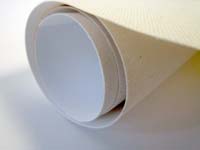 |
Inkjet printer Inkjet printers are a type of computer printer that operate by propelling tiny droplets of liquid ink onto paper. They are the most common type of computer printer for the general consumer due to their low cost, high quality output, ability to print in vivid color, and ease of use.
At KeenART Media, all our canvas prints and fine art prints are created using a top-quality inkjet printer. |
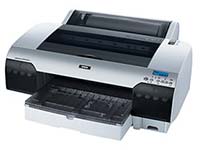 |
J ^^Top
Jpeg or jpg A digital format used for images. Jpegs are considered "lossy" file types, which means that when the image data is compressed (for easier storage and transfer), some detail may be lost.
Though jpegs are perfectly acceptable for printing and can produce a quality printed image, they are not as highly recommended as TIFF files. |
L ^^Top
Lamination Lamination is a process of bonding thin layers of material together to create a composite structure with improved strength, durability, and surface properties. In printing and graphic arts, lamination involves applying a thin layer of clear plastic film, such as polyester or polypropylene, to the surface of printed materials using heat and pressure. Lamination protects printed materials from moisture, abrasion, UV radiation, and other environmental factors, extending their lifespan and enhancing their appearance. Laminated prints are commonly used for outdoor signage, banners, posters, menus, ID cards, and other applications requiring durability and weather resistance. |
Landscape Orientation Refers to the angle at which the framed or canvas image is hung. Landscape oriented images are those displayed lengthwise, so that the top edge (parallel to the floor) is the long dimension of the painting, and the side edge is the short dimension.
Also referred to as "horizontal orientation".
The opposite of "portrait orientation". |
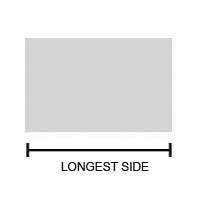 |
Laser Engraving Laser engraving is a versatile and precise method of creating deep, permanent marks, patterns, or designs on a variety of materials, including metals, plastics, wood, leather, glass, and stone. In laser engraving, the focused laser beam interacts with the material's surface, removing material through ablation or vaporization to create recessed or raised areas with high resolution and detail.
Laser engraving offers advantages such as high speed, accuracy, repeatability, and the ability to produce intricate designs, text, logos, and images with sharp edges and fine details. Laser engraving is used in various industries and applications, including awards and trophies, signage, jewelry, woodworking, personalized gifts, architectural models, and industrial part marking. Laser engraving systems may employ different laser sources, including CO2 lasers, fiber lasers, and diode lasers, each offering specific advantages in terms of wavelength, power, and material compatibility for different engraving applications. |
| Latex Ink A relatively new type of inkjet ink,offered as an alternative to solvent inks. A water carrier is mixed with a polymer dye, which is then applied to the substrate using heat. Unlike traditional solvent inks, latex inks are odorless, which eliminates ventilation issues. |
Lens A lens is a transparent optical component or device that refracts or bends light rays passing through it, focusing or diverging them to form an image. Lenses are essential elements in optical systems, cameras, telescopes, microscopes, eyeglasses, and other imaging devices, where they play a crucial role in magnifying, magnifying, and manipulating light to capture, project, or view images.
Lenses can be made from various materials, such as glass, plastic, and crystalline substances, and come in different shapes, sizes, and configurations, including convex lenses, concave lenses, cylindrical lenses, and aspherical lenses. Lenses exhibit properties such as focal length, optical power, aberrations, and aperture size, which determine their optical performance and imaging characteristics. By controlling the curvature and thickness of the lens surfaces, designers can achieve precise control over the focusing, resolution, and distortion of images in optical systems. |
Lens Flare Lens flare is a visual phenomenon characterized by unwanted artifacts or patterns of light that appear in an image as a result of light sources hitting the camera lens at oblique angles. Lens flare can manifest as streaks, circles, or geometric shapes of varying intensity and color, depending on the characteristics of the lens, the angle of the light source, and the position of the camera. Lens flare is caused by internal reflections and scattering of light within the lens elements, particularly when shooting towards bright light sources such as the sun or artificial light sources.
While lens flare is often considered a technical flaw and may detract from the overall image quality, it can also be used creatively to add visual interest, mood, and atmosphere to a photograph. Some photographers intentionally incorporate lens flare into their compositions to create artistic effects or evoke a sense of warmth, nostalgia, or drama. Lens hoods and lens coatings are commonly used to minimize or prevent lens flare by reducing the amount of stray light entering the lens and improving contrast and color saturation in images. |
Lens Hood A lens hood is a cylindrical or conical accessory that attaches to the front of a camera lens to block unwanted light from entering the lens and causing lens flare, ghosting, or reduced contrast in images. Lens hoods are designed to extend beyond the front element of the lens, shading it from direct sunlight, stray light, and other sources of glare.
By preventing extraneous light from hitting the lens at oblique angles, lens hoods help maintain optimal image quality, color saturation, and contrast, especially in bright outdoor conditions or when shooting towards the sun. Lens hoods come in various shapes and sizes to match specific lens designs and focal lengths. Some lens hoods are reversible or collapsible for compact storage when not in use. While lens hoods are primarily used to improve image quality, they also provide physical protection for the front lens element against accidental bumps, scratches, and damage. |
Lens Mount A lens mount refers to the mechanical interface and attachment mechanism used to connect a camera lens to a camera body. Lens mounts vary depending on the camera system and manufacturer, with each mount design featuring specific dimensions, alignment pins, and electronic contacts for communication between the lens and camera body. Common lens mount systems include Canon EF, Nikon F, Sony E, Fujifilm X, and Micro Four Thirds, among others.
Each lens mount is designed to ensure precise alignment and secure attachment of the lens to the camera body, enabling proper focusing, aperture control, and communication of lens data and metadata. Lens mounts may also support features such as autofocus, image stabilization, and electronic lens control, depending on the compatibility and specifications of the camera and lens system. |
Lens Speed Lens speed, also known as lens aperture or lens brightness, refers to the maximum aperture diameter of a camera lens, expressed as a numerical f-stop value. A lens with a larger maximum aperture (smaller f-stop number) is considered "faster" because it allows more light to pass through the lens to the camera sensor, enabling faster shutter speeds and better performance in low-light conditions.
Fast lenses are desirable for situations where capturing fast-moving subjects, achieving shallow depth of field, or shooting in dimly lit environments is required. The speed of a lens is determined by its maximum aperture size relative to the focal length of the lens. For example, a lens with a maximum aperture of f/2.8 is considered faster than a lens with a maximum aperture of f/4.0. Fast lenses are commonly used in portrait photography, sports photography, and photojournalism, where the ability to capture sharp, well-exposed images in challenging lighting conditions is essential. |
| Limited Edition In printmaking, multiples of a print struck from the same plate may be limited to a certain number of copies. This also refers to other forms of published artwork that are identical, usually published at the same time, and limited to a quoted number. For prints, edition numbers are conventionally marked in pencil using fraction format: the bottom number indicates the total number of prints in the edition, and the top number indicates the order in which the print was signed. The publisher undertakes not to produce more than edition size. The smaller the edition size, the more rare the print, and hence the higher the potential value. Edition sizes range from an edition of 2 to thousands. In practice, editions of more than 750 prints have little, if any, extra value. |
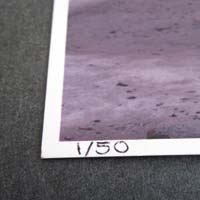 |
| Limited Edition Print When an artist prints a run of the same image, they determine how many of that image are to be printed. If they choose to print only 100, or 1000 copies of one image, it is limited edition. Each print will usually feature the print number (34/100) and the artist's signature. The more exclusive the piece (the fewer prints), the more expensive and valuable. |
Linen Canvas Artist's canvas is make from a variety of fabrics. Linen and cotton are the most common.
Linen is more expensive. It is longer lasting, due in part to the oils retained in the canvas that keep it pliable, and less likely to expand, due to the equally weighted threads used to construct the canvas. |
Liner A frame molding used within the outer molding/picture frame, sometimes called a "linen liner" or "insert". The may be covered with fabric, such as velvet or linen. Many liners are made from fully finished frame stock, including gold or silver. The liner serves the same purpose as a mat: to provide a distraction-free space between the art and the frame, and enhance the artwork.
Liners are paired with stretched and mounted canvas prints or paintings, and do not require a clear glass or acrylic cover. A liner may also be used on large, glass-covered artwork, as the largest mat size available is 32x40". If it is more than 2 1/2 inches wide, it is called a "panel". 
Order online: Linen Liners |
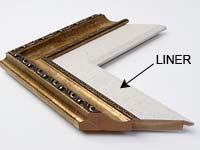 |
| Linocut Linocut is a printmaking technique in which a design is carved into the surface of a linoleum block using cutting tools, leaving raised areas that will receive ink for printing. The linoleum block is then inked with a roller, and paper is pressed onto the block to transfer the inked design onto the paper. Linocut prints are characterized by their bold lines, textures, and graphic quality, resulting from the relief surface of the linoleum block. Artists can create multiple prints from a single linoleum block, varying the colors, papers, and printing techniques to achieve different effects. Linocut is a versatile and accessible printmaking technique popular among artists, illustrators, and printmakers for its expressive potential and tactile qualities. |
Lithograph A copy of a work that is created by the artist himself (ie: not a print created years later from a digital image).
The artist creates a mirror image of the artwork using grease pencils on stone. Oil-based ink is then applied to the piece, and bonds with the grease but avoids the uncolored areas. Canvas or paper is then laid over the plate and pressed to transfer the ink onto the material. The plate is then re-inked for the next sheet of material. |
Lithography The process of producing a picture, writing, or the like, on a flat, specially prepared stone, with some greasy or oily substance, and of taking ink impressions from this as in ordinary printing.
It was invented in 1796 by German author Alois Senefelder as a cheap method of publishing theatrical works. Lithography can be used to print text or artwork onto paper or other suitable material. |
Luminance Luminance refers to the brightness or intensity of light emitted or reflected from a surface, as perceived by the human eye. In digital imaging and color science, luminance is one of the components of color representation, along with chrominance. Luminance represents the black-and-white information or brightness values in an image, while chrominance represents the color information or hue and saturation values.
Luminance is often measured in units such as candelas per square meter (cd/m²) or relative values on a scale from 0 to 100, with 0 representing absolute black and 100 representing the brightest white. In digital imaging, luminance values are typically represented in grayscale images or luminance channels of color images, where variations in luminance contribute to contrast, tonal range, and overall image brightness. |
| Lustre Finish A semi-glossy finish that reflects light without compromising the image with a visible reflection. |
M ^^Top
Magenta Magenta is a primary color in the subtractive color model, along with cyan and yellow. Magenta is one of the three primary colors used in color printing and reproduction processes, such as CMYK printing, where it serves as one of the ink colors used to create a wide range of colors and hues. Magenta is a purplish-red color with a dominant hue that lies between red and blue on the color wheel. Magenta is commonly used in color printing to reproduce a variety of colors, including reds, purples, pinks, and blues, by mixing different combinations of cyan, magenta, yellow, and black inks or toners. |
Masking tape A pressure sensitive, self adhesive that is easy to tear and generally cream or white in color. It is available in various widths and is popular for protecting areas adjacent to those to be painted, due to its ease of removal. Various strengths are available, and are rated 1-100 based on the adhesion.
Order online: We offer various Tapes and Adhesives |
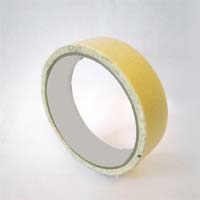 |
| Matte Finish A non-glossy, "flat" finish that creates an even reflective surface with no glare. Matte paper is generally smooth in texture. |
Megapixel A megapixel is a unit of measurement used to quantify the resolution of digital images, representing one million pixels. It is commonly used to describe the resolution capability of digital cameras, camera sensors, and digital displays. The number of megapixels in an image indicates the total number of individual pixels that compose the image, with higher megapixel counts corresponding to higher image resolutions and potential for finer detail and larger print sizes.
For example, an image captured by a camera with a resolution of 12 megapixels contains approximately 12 million pixels, while an image captured by a camera with a resolution of 24 megapixels contains approximately 24 million pixels. The megapixel count alone does not determine image quality, as factors such as sensor size, pixel size, lens quality, and image processing also play significant roles. However, higher megapixel counts generally allow for greater flexibility in cropping, printing large-format images, and capturing finer details, particularly in situations where high-resolution output is desired. |
Memory Card A memory card is a portable storage device used to store digital data, such as photographs, videos, audio files, and documents. Memory cards are commonly used in digital cameras, camcorders, smartphones, tablets, and other electronic devices that require removable storage for capturing and storing multimedia content. Memory cards come in various formats and capacities, including Secure Digital (SD), CompactFlash (CF), microSD, Memory Stick, and others, each with its own physical size, storage capacity, and data transfer speed.
The storage capacity of memory cards ranges from a few gigabytes to several terabytes, allowing users to store thousands of photos, hours of video footage, and large data files. Memory cards are designed to be durable, shock-resistant, and capable of withstanding extreme temperatures and environmental conditions, making them suitable for use in demanding situations such as outdoor photography, sports photography, and professional videography. When choosing a memory card, factors to consider include storage capacity, data transfer speed, compatibility with the device, and reliability for long-term storage and data retention. Regular backup and proper handling of memory cards are essential to prevent data loss and ensure the integrity of stored digital content. |
| Metallic Paper Metallic paper is a type of printing paper with a metallic or pearlescent finish that imparts a subtle shimmer or metallic sheen to printed images. Metallic paper is coated with metallic pigments or reflective layers that enhance color saturation, contrast, and luminosity, giving images a unique, three-dimensional appearance with depth and vibrancy. Metallic paper is commonly used for high-end photography, fine art prints, luxury packaging, greeting cards, and marketing materials to create eye-catching, premium-quality reproductions. Metallic paper is available in various weights, surface textures, and finishes to suit different printing techniques and applications. |
Moiré Pattern A moiré pattern is an interference pattern that occurs when two sets of repetitive patterns, such as lines, grids, or textures, overlap or are slightly out of alignment with each other. Moiré patterns manifest as unwanted visual artifacts or shimmering effects in digital images, caused by the interaction between the repeating patterns in the subject and the grid-like arrangement of pixels on the camera sensor. Moiré patterns are more likely to occur when photographing subjects with fine, high-frequency textures or patterns, such as textiles, screens, or architectural details.
The appearance of moiré patterns can be minimized by adjusting the shooting angle, changing the distance from the subject, or using anti-aliasing filters in front of the camera sensor to blur fine details and reduce interference patterns. In post-processing, moiré patterns can be corrected using specialized software tools or by applying selective blurring or sharpening techniques to affected areas of the image. Understanding the causes and characteristics of moiré patterns is important for photographers to minimize their occurrence and preserve image quality in digital photography. |
Monochrome Monochrome refers to images that are composed of varying shades of a single color, typically black, white, or grayscale. In photography, monochrome images lack color information and are represented solely by variations in brightness and contrast. Monochrome photography emphasizes shape, form, texture, and tonality, allowing photographers to convey mood, atmosphere, and emotion through the interplay of light and shadow.
Common techniques for creating monochrome images include converting color photographs to grayscale or shooting with black-and-white film. Monochrome images often evoke a timeless and classic aesthetic, and they are widely used in fine art photography, portrait photography, street photography, and documentary photography to capture the essence of a subject without the distraction of color. |
| Mottle Mottle refers to an uneven distribution or irregular pattern of color, tone, or texture in a surface or material, resulting in blotchy or speckled appearance. Mottling can occur naturally in organic materials, such as wood, stone, or marble, due to variations in grain, density, or mineral content. In printing and reproduction processes, mottling can occur when ink or pigment is inconsistently applied or absorbed by the substrate, resulting in areas of uneven color or density. Mottling can also occur in digital imaging due to compression artifacts, noise, or interpolation errors. In some cases, mottling may be intentional and used for artistic effect, while in others, it may be undesirable and corrected through adjustments in printing or image processing. |
Mounting Mounting refers to the process of attaching or securing a print, artwork, photograph, or other two-dimensional object onto a backing board, mat, frame, or display surface for presentation, protection, or preservation. Mounting techniques vary depending on the size, weight, and characteristics of the object being mounted, as well as the desired display method and aesthetic preferences.
Common mounting methods include dry mounting (using adhesives or heat to bond the print to a backing board), hinge mounting (attaching the print to a mat or backing board using archival hinges), float mounting (suspending the print within a frame or display case), and pressure-sensitive mounting (using adhesive sheets or tapes to adhere the print to a substrate). Proper mounting ensures that prints are securely held in place, flat, and protected from damage or deterioration over time. |
Museum Wrap While "gallery wrap" refers simply to the process of wrapping a canvas all the way around the stretcher bar frame and affixing it to the back, "Museum wrap" refers to the color on the drop edges (sides) of the canvas). In a museum wrap, the entire image is confined to the front of the canvas, and the sides are a solid color or white. This may be due to canvases in museums and galleries generally being frames, so the edges were never visible.
There appears to be some disagreement about whether museum wrap is limited to canvases wrapped on 1 1/2" in stretcher bars, or if the depth of the bar does not matter for the designation. |
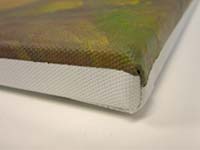 |
N ^^Top
Nail-less hangers Any hanger or hook that does not require a nail to affix it to the frame or wall.
(1) sawtooth hangers generally have a pointed tip on each end that can be pressed or hammered into the top back of the frame. A nail or other hook is required to hang it on the wall, however.
(2) Adhesive hangers are popular today, and are comprised of a flat, double-sided adhesive that affixes the hanger to the wall. When the hanger needs to be removed, a tab attached to the adhesive is pulled, and the entire piece comes off without ruining the wall.
(3) A hanger with sharp teeth that can be pressed or hammered into the wall. The face is then flush with the wall, providing a jutting hook on which to hang the artwork. |
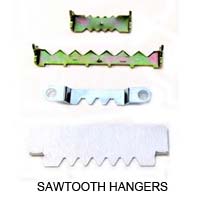 |
| Negative A negative is an image, usually on a strip or sheet of transparent plastic film, in which the lightest areas of the photographed subject appear darkest and the darkest areas appear lightest. This reversed order occurs because the extremely light-sensitive chemicals a camera film must use to capture an image quickly enough for ordinary picture-taking are darkened, rather than bleached, by exposure to light and subsequent photographic processing. |
Noise Reduction Noise reduction is the process of minimizing or eliminating unwanted noise from digital images to improve overall image quality and clarity. In digital photography, noise reduction techniques are used to reduce the visibility of noise artifacts, such as grain or speckles, caused by factors such as high ISO sensitivity, low-light conditions, or limitations in the camera's image sensor. Noise reduction algorithms analyze the pixel data in an image and apply smoothing or averaging techniques to suppress noise while preserving image detail and sharpness.
Many digital cameras feature built-in noise reduction settings that automatically apply noise reduction processing to images during capture, while advanced image editing software also offers noise reduction tools that allow photographers to fine-tune noise reduction parameters during post-processing. When applying noise reduction, it's important to strike a balance between noise reduction and image sharpness, as excessive noise reduction can result in loss of detail and a "plastic" appearance in the final image. Photographers should experiment with different noise reduction settings and techniques to achieve the desired balance between noise reduction and image quality in their photographs. |
| Non-Glare Glass Glass where one or both surfaces have been treated chemically or mechanically to slightly roughen the surface, causing reflected incident light to be dispersed in all directions. Because the glass surface is not smooth, art images behind the glass tend to be softened. The softness depends on how far the art is from the glass. No more than two or three mats are recommended to be used with non-glare glass. If clarity is desired, objects in deep frames (shadow boxes) should not be displayed with non-glare glass. |
Numbered Ducks A type of cotton canvas that subscribes to a numbering system that identifies the weight of the cloth. Numbered duck has a weight of less than 19 ounces per 36x22" piece. Duck canvas with a higher weight is called naught duck.
Order online: #10 and #12 Canvas |
O ^^Top
OBA Optical brightening agents.
A class of chemicals that absorb light energy in one spectrum and emit it in another. When applied to white paper, an OBA can lessen a yellowed appearance. Also called "fluorescent lightening agents", it is applied to some fine art papers to create the bright white often desired. Whether or not OBAs have an archival lifespan is still contested. |
Offset Clips Used to affix a stretched canvas to a frame. Also known as a “Z bracket”, this stepped metal hardware has a hole in either end through which a screw or nail is driven. One end of the bracket is fastened to the stretcher bar frame, the other to the back of the picture frame. Offset clips allow for artwork that is slightly larger or smaller than the depth of the frame rabbet to be fitted. They are also used to attach a canvas to a floater frame.
Order online: Offset Clips |
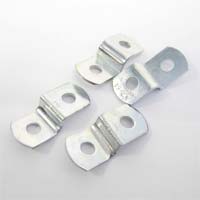 |
Offset Printing Offset printing, also known as offset lithography, is a widely used printing technique in which ink is transferred from a printing plate to a rubber blanket cylinder and then onto the printing substrate, typically paper. Offset printing is based on the principle of oil and water repulsion, where the image areas on the printing plate attract ink, while the non-image areas repel ink.
Offset printing is capable of producing high-quality prints with sharp detail, vibrant colors, and consistent results, making it suitable for a wide range of applications, including newspapers, magazines, books, packaging, and marketing materials. Offset printing offers advantages such as fast printing speeds, cost-effectiveness for large print runs, and compatibility with a variety of paper stocks and finishes. |
Opacity Opacity refers to the degree to which a material or substance blocks the transmission of light or allows objects behind it to be obscured or concealed. In the context of printing, opacity is an important property of paper, ink, and other printing materials that affects the visibility and legibility of printed text, images, and graphics. Opacity is typically expressed as a percentage, with higher opacity indicating greater light-blocking ability and less see-through or show-through of underlying layers.
Opacity is influenced by factors such as paper thickness, weight, and composition, as well as ink coverage, color density, and printing process. High-opacity papers are preferred for double-sided printing, where text and images must remain legible without interference from content printed on the reverse side. |
Open edition prints An open edition print has no limit to the number of copies made. While a limited edition print has a set number - 10, 50, or 1000, for instance, after which time no more copies will be made - open edition implies the artist can continue making prints indefinitely.
As a result, open edition prints are generally cheaper than limited editions, and will not amass the same value over time.
|
 |
Overexposed In photography, exposure relates to the amount of light that was allowed to affect the image, either through the viewfinder of the camera, or in the darkroom during film development.
An overexposed image will have more light than average (generally considered too much, though some artists deliberately overexpose their images). Overexposure tends to make an image whiter, obscuring details in areas that were already well lit.
For example, if the subject is in front of a bright light, the background often must be overexposed in order for the subject's face to be visible.
|
 |
| Overlap Similar to "offset", this refers to the amount of the artwork a picture frame lip or mat will cover on each side of the piece. An overlap is necessary to keep the contents behind from falling through the opening. |
P ^^Top
Panorama A broad, wide-angle view of much of the - or the entire - space surrounding the viewer. Panoramas are usually scenic and have a height to width ratio of 1:2 or more. |
 |
Paper weights The weight of a piece of paper is defined by the weight in grams per square meter (gsm). Alternately, weight may be determined by what a set number of sheets would weigh in pounds. Regular bond paper that one might use in a desktop printer is generally 90 gsm or 20-24 lb.
A general breakdown of paper weights by gsm:
35-55 gsm: newspaper
130-170 gsm: posters
350 gsm: business cards |
| Photoshop Digital image (raster graphics) editing software developed by Adobe. Simply defined, Photoshop allows the user to alter photographs and other digital images by applying layers of filters. Objects can be removed from the image, colors and tones can be changed, and effects can be applied to make the image look, for instance, like a watercolor painting or pencil sketch. |
Pigment A pigment is a material that changes the color of light it reflects as the result of selective color absorption. This physical process differs from fluorescence, phosphorescence, and other forms of luminescence, in which the material itself emits light. Many materials selectively absorb certain wavelengths of light. Materials that humans have chosen and developed for use as pigments usually have special properties that make them ideal for coloring other materials. A pigment must have a high tinting strength relative to the materials it colors. It must be stable in solid form at ambient temperatures.
For industrial applications, as well as in the arts, permanence and stability are desirable properties. Pigments that are not permanent are called fugitive. Fugitive pigments fade over time, or with exposure to light, while some eventually blacken. |
| Pissarro, Camille 1830-1903: A Danish-French Impressionist painter who inspired Renoir and Cezanne. Order a Pissarro classic painting print today. |
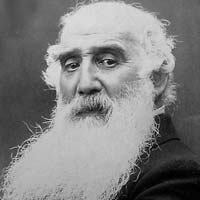 |
| Pixel A pixel is a small dot that represents a single element of a display. |
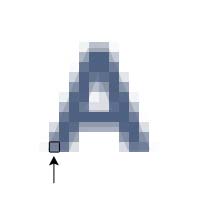 |
Platen Press Cleaner A solution used to remove left over adhesive from the surface of a platen press.
Platens are flat metal (originally wood) plates that are pressed with great force against paper to create an impression. They were originally used in letterpress printing, and today are used to cut, crease or number digital or other prints. |
| PMMA PMMA or acrylic is a widely used transparent plastic material known for its applications in various markets from picture framing, car windows, smartphone screens to aquariums. It is a tough plastic, easy to shape and a great alternative to the high cost and less resilient glass. |
| Polyester Resin A type of viscous polymer that is often used in casting (poured into molds). Polyester Resin differs from epoxy resin in that it has less strength, is less adhesive, and tends to shrink. For these reasons, it is not often used as a coating, as epoxy resin is. |
Post-Processing Post-processing, also known as image editing or digital darkroom techniques, refers to the process of enhancing, retouching, and refining digital photographs using software tools and techniques after they have been captured with a camera. Post-processing allows photographers to adjust various aspects of the image, including exposure, contrast, color balance, sharpness, and composition, to achieve the desired aesthetic and visual impact.
Common post-processing tasks include cropping and straightening images, adjusting exposure and white balance, enhancing colors and contrast, removing blemishes or distractions, applying creative filters and effects, and optimizing images for printing or online sharing. Popular post-processing software options include Adobe Photoshop, Adobe Lightroom, Capture One, Affinity Photo, and GIMP (GNU Image Manipulation Program), among others. Post-processing plays a crucial role in the digital photography workflow, allowing photographers to refine their vision, correct technical imperfections, and express their creativity through the manipulation and enhancement of digital images. |
| Pressure-Sensitive Mounting The act of affixing an artwork to another surface (foam core, gatorboard, dibond, wood panelling, canvas, etc) with an adhesive that does not require heat or a chemical additive to adhere to the artwork's surface. The materials will stick together using the force of the hand, or a press designed to apply a great amount of pressure. |
| Primary Colors A set of colors that, when combined, present as different colors. Red, green and blue are additive primary colors. When overlapped in different ratios, new colors are created. Yellow, cyan and magenta are subtractive primary colors used in mixing pigments or dyes. |
 |
Primed canvas A blank painter's canvas coated with a lead paint that reduces the absorbency of the canvas and improves the application the artist's paint. Canvas may be single or double-primed, as well as coated for a specific use, such as acrylic or oil paints.
KeenART Media offers double-primed and unprimed blank artist canvases for sale.
Order online: Artist Canvas |
Print Size Print size refers to the dimensions of a printed image when reproduced on a physical medium, such as paper, canvas, or other printable substrates. Print size is typically measured in inches or centimeters and represents the width and height of the printed image. The print size is determined by factors such as the resolution of the digital image file, the aspect ratio of the image, and the dimensions of the physical print medium.
When printing digital images, photographers and designers often consider factors such as viewing distance, intended use, and display environment to determine the optimal print size for achieving the desired visual impact and readability. Large print sizes are suitable for wall art, gallery exhibitions, and poster displays, while smaller print sizes may be more appropriate for photo albums, greeting cards, or promotional materials. The choice of print size also affects the level of detail and clarity of the printed image, with larger prints requiring higher resolution digital files to maintain sharpness and image quality. |
| Proof Sheet A small section of a digital image printed on canvas in order to determine the color saturation and texture of the inks on that particular surface. Often, multiple proofs will be printed on different surfaces with various color levels, in order to compare the results. |
Q ^^Top
Quire Twenty-Five sheets of any paper, one twentieth of a ream. |
R ^^Top
Raster Image Processor (RIP) A raster image processor (RIP) is a software component or device driver used in laser engraving systems to interpret, process, and convert raster image files into engraving commands that control laser behavior. RIP software analyzes raster image data, including pixel colors, densities, and patterns, and generates engraving instructions such as laser power levels, scan speeds, and pixel mapping coordinates.
RIP software plays a critical role in optimizing engraving quality, speed, and efficiency by applying image processing algorithms, dithering techniques, and halftone patterns to raster images. Advanced RIP software may also support color management, image editing, and engraving parameter customization, allowing operators to achieve precise and accurate engraving results for a wide range of applications and materials.
Advanced RIP systems offer features such as advanced color management, screening algorithms, ink optimization, and workflow automation to optimize print quality, efficiency, and productivity. |
| Renoir, Auguste 1841-1919: A French impressionism painter who worked alongside Claude Monet, Alfred Sisley, and Camille Pissaro. Order a Renoir classic art print today. |
 |
| Reproduction A reproduction is a copy of an original. This copy may be made using the same materials as the original (for instance, one artist reproducing an earlier artwork), or a digital copy of the original may be created using a printer. Reproductions make it possible for the artist to sell the same work to multiple buyers, and allow collectors to purchase a less costly version of an original artwork. |
Resin Coating A viscous, liquid epoxy resin is poured over the mounted paper print or reinforced stretched canvas to produce a smooth, clear surface. Once cured, the hardened resin creates a high-shine, glass-like coating that enhances color and dimension to the artwork.
Order your resin coated fine art print today.
Order Online: Epoxy Resin Ex-74 |
Resolution Every digital image is made up of picture elements (pixels). The number of pixels determines the resolution.
The more pixels your photo has, the clearer your photo remains as you increase its size. |
| RGB A color mode or system representing the primary colors that are combined to display all the colors seen on a traditional computer monitor. It stands for Red, Green, Blue. |
Rigid Backing Foam core (also called foam board) and Gatorboard can be used as backings in picture framing, to keep the artwork safe from dust and damage. Alternately, paper prints can be dry mounted onto foam core, Gatorboard or dibond (aluminum sheeting) for a frameless, laminated display.
Occasionally, prints are mounted onto wood boards to provide additional support for resin coatings or plexi face mounting.
Order Online: Rigid Backing Boards |
Rubber pads Also called bumpers or bumps, these half sphere, self-adhesive pads are placed in the bottom corners of a picture frame or canvas print to keep it from scratching or scuffing the wall when hung. Foam bumpers are also available.
Order online: Bumpers |
S ^^Top
Satin Finish As opposed to the high shine of a glossy finish, satin finish has what is referred to as a sheen - a smoother, velvet-like softness. It is closer to a matte finish, but slightly more reflective. |
Saturation Saturation, also known as chroma or intensity, refers to the purity or vividness of a color, representing the degree to which it appears rich, vibrant, or intense. Highly saturated colors appear vivid and distinct, while desaturated colors appear duller or washed out. HSL, which stands for Hue, Saturation, and Luminance, is a color model used in digital image processing and editing to manipulate and adjust the colors within an image. Each component of the HSL color model represents a different aspect of color:
Hue: Hue refers to the pure color of an object, represented as a point on the color wheel. It defines the specific wavelength of light that is perceived by the human eye, ranging from red to orange, yellow, green, cyan, blue, and violet.
Saturation: Saturation determines the intensity or purity of a color. A fully saturated color appears vivid and vibrant, while a desaturated color contains more gray and appears dull or muted.
Luminance: Luminance refers to the brightness or lightness of a color. It represents the amount of light reflected by an object or surface, ranging from black (0% luminance) to white (100% luminance).
By adjusting the values of hue, saturation, and luminance independently, photographers and digital artists can fine-tune and manipulate the colors within an image to achieve desired visual effects, correct color casts, or enhance the overall color balance. |
Scanning Scanning is the process of converting physical documents, photographs, or images into digital format using a scanner or scanning device. During scanning, the scanner captures the optical characteristics of the original document or image and converts them into digital data, typically in the form of a raster image file (e.g., JPEG, TIFF, PNG). Scanning is commonly used for digitizing printed documents, photographs, artwork, and other visual materials for storage, distribution, manipulation, and display in electronic formats.
Order your high quality artwork scan with our easy, online order system. |
 |
| Schiele, Egon (1890-1918) An Austrian painter mentored by Gustav Klimt, who is known for his raw imagery. We offer classic art prints by Egon Schiele. |
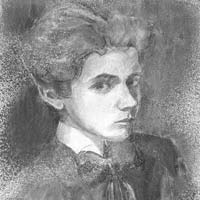 |
| Self-leveling A variety of viscous products that will spread until the surface is even, without any need for manual smoothing. For example: resin coating. |
| Sepia A treatment that can be digitally applied to an image to give make it brown-tinted monotone in color. Sepia is meant to mimic the color of developed film photographs from the early and mid 20th century. |
 |
Sharpness Sharpness refers to the clarity and definition of details in an image, including fine textures, edges, and contours. A sharp image exhibits well-defined edges, crisp details, and high contrast between adjacent elements, resulting in a clear and visually pleasing appearance. Sharpness is influenced by various factors, including camera settings, lens quality, focus accuracy, and image processing techniques. Achieving optimal sharpness requires careful attention to these factors during image capture and post-processing.
While sharpness is often desirable in photography, it's important to recognize that the perceived level of sharpness can vary depending on factors such as viewing distance, display size, and image content. Photographers may choose to adjust sharpness settings during post-processing to enhance image clarity and visual impact, taking into account the specific characteristics and requirements of each image. |
| Shellac A liquid coating derived from the excretion of a beetle found in India and Thailand. When the dried flakes are mixed with ethanol, they become a natural primer that dries solid and serves as a protective insulator, sealant or stain. Today, real shellac has been largely replaced by chemically-produced lacquer. |
Silicone Paper A type of paper that is treated with a silicone coating which prevents it from sticking to whatever it is laid against. Often used to separate artworks from one another, or placed over an artwork prior to rolling, so it does not stick to itself.
Similar to Release Paper. |
| Sintra Sintra is lightweight PVC board. Sintra has a uniform, fine, closed-cell structure that provides a low gloss satin finished surface. They are highly rigid and impact resistant. Durable for interior and exterior applications with a very high aversion to corrosion & water absorption. They are self-extinguishing and flame resistant. Available in black or white, 3mm(1/8") & 6mm(1/4") thicknesses. |
| Sisley, Alfred (1839-1899) A British impressionist landscape painter who worked closely with Monet, Bazille, and Renoir. We have many classic art print by Alfred Sisley. |
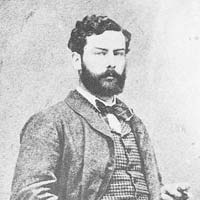 |
Solvent Inks An ink formulated for inkjet printers, ideal for printing directly to vinyl and other plastics. The corrosive nature of the compounds "eat" into the surface of the substrate, securing the pigment or dye.
As a result, solvent inks are waterproof, scratch resistant, and fade proof, perfect for outdoor signage and billboard displays.
Solvent ink can also refer to any type of printer ink that is not water-based.
|
| Standoff Bolts A type of metal fastener that is attached a mounted artwork (generally a plexi mount or dibond) that creates a space and shadow between the art and the wall. The bold has a flat or gently rounded, sometimes brushed silver head attached to a screw base. The screw is inserted through a hole in the corner of the artwork. Then a wide washer is placed over the screw, between the artwork back and the wall. The remainder of the protruding screw is then screwed into the wall. The result is a contemporary, frameless display style, with only the smooth heads of the bolts showing in the top two or all four corners of the artwork. |
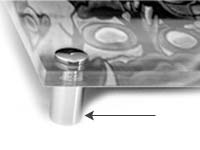 |
Stapler A handheld tool used to fasten multiple things together. The stapler is generally activated by squeezing a trigger that shoots a bent metal rod through the materials, and may fold it down on the other side to hold it in place.
Heavy duty staplers can be used to secure pieces of wood or even metal. In picture framing, a heavy duty pneumatic stapler is used to affix the stretched canvas to the back of the stretcher bar frame. |
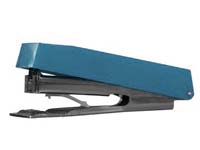 |
Strap Hangers Metal hardware used to hang picture frames that is made of a triangular metal hoop or D-ring, with a flat metal length doubled over around it, through which the screws or nails are placed. Depending on the size of the frame, a framer may use a 1-hole, 2-hole, 3-hole or even 4-hole hanger, with the screws running down the length of the frame moulding.
Order online: Strap Picture Hangers |
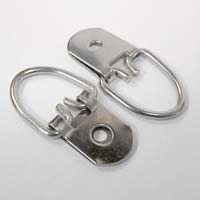 |
Stretched Canvas A canvas that has been stretched and mounted onto a stretcher bar frame. It can now be framed or hung on the wall as is.
Order your one-of-a-kind stretched canvas print today. |
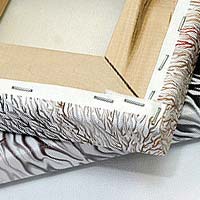 |
Stretcher bar A stretcher bar is used to construct a wooden stretcher frame used by artists to mount their canvases. They are traditionally a wooden framework support on which an artist fastens a piece of canvas.
They are also used for small-scale embroidery to provide steady tension, affixing the edges of the fabric with push-pins or a staple gun before beginning to sew, and then removing it from the stretcher when the work is complete. Stretchers are usually in the shape of a rectangle, although shaped canvases are also possible.
Since a stretcher is simply a frame, it can be constructed in a variety of ways. The differences in construction have to do with how the corners are built. Commercially available, pre-fabricated stretchers come in segments with interlocking corners that can be fit together like puzzle pieces.
Order online:
Stretcher Bars
Custom-made Stretcher Bar Frames
|
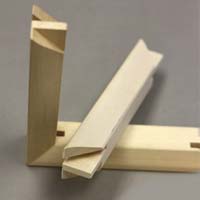 |
Stretcher frames A wooden frame made from lengths of wood (stretcher bars), around which a canvas painting or print is tightly stretched and stapled or nailed in place.
Lengths of wood are cut at a 45 degree angle with a miter saw or chopper, and joined with V nails using an underpinner machine. If the frame is large, extra cross beams may be inserted for added support.
Stretcher bars come in a wide range of depths, depending on the artist or customer's preference. The most common stretcher frame depths are 1 1 1/2" and 3/4". The depth translates to how far out from the wall the face of the canvas will protrude when hung. When a stretched canvas is being framed in a regular picture frame, the framer may use a very shallow stretcher bar of 1/2" or 7/16".
Order online: Custom-made Stretcher Bar Frames |
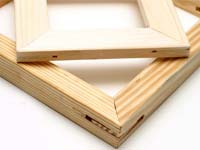 |
Stretcher Key Small wedges of wood that can be inserted into the corners of a stretcher bar frame to make it a little bit larger. This is done because canvases can stretch out over time, and begin to sag on the frame.
Stretcher keys work only for half lap-jointed stretcher bars, because there is a gap within the wood. If the frame was constructed by a framer and attached with mitered corners, this method will not work. |
Sublimation Sublimation is a process where an image can be printed onto transfer paper using dye-based inks and then with heat and pressure become transferred into the substrate.
Dye sublimation on hard surface surfaces is possible if the surfaces have been coated. Instead of printing images directly on a surface, which may scratch easily, the image is infused into the coating to provide permanent protection and durability.
|
| Substrate In printing and imaging, a substrate refers to the underlying material or surface onto which images, text, or graphics are printed or transferred. Common substrates include paper, cardboard, canvas, fabric, plastic, metal, glass, and wood. The choice of substrate depends on factors such as the printing process, intended use, durability requirements, and desired aesthetic qualities. Substrates vary in characteristics such as texture, weight, opacity, absorbency, smoothness, and finish, influencing the visual appearance, tactile feel, and longevity of printed materials. |
T ^^Top
Thick Gallery Wrap Any stretched canvas that has been wrapped around a stretcher bar frame that is 1 1/2" deep. The depth translates to the distance the viewed portion of the canvas will extend from the wall (the width of the drop edge).
Order your thick gallery wrapped canvas print using our easy online ordering process.
Or order 1-1/2 inch Stretcher Bars, unassembled |
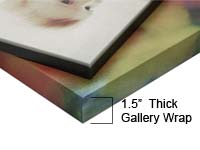 |
Thin Gallery Wrap Any stretched canvas that has been wrapped around a stretcher bar frame that is 3/4" deep. The depth translates to the distance the viewed portion of the canvas will extend from the wall (the width of the drop edge).
Order your thin gallery wrapped canvas print using our easy online ordering process.
Or order 3/4 inch Stretcher Bars, unassembled |
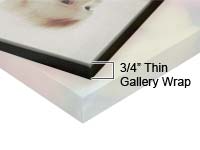 |
TIFF A lossless image file type that allows the digital image to shared and transferred without dropping any information in the compression, therefore resulting in an image almost identical to the one taken on the camera.
It is "platform independent" which means most image editing software can open and edit the files. |
| Tint A tint is a color created when a solid color is mixed with white, creating a lighter version of the color. In contrast, a "shade" is a color mixed with black to create a darker version of the color. In printing and color reproduction, a tint refers to a variation of a base color achieved by adding white or another lightening agent to lighten or dilute the color's intensity. Tints are commonly used to create subtle variations in color, achieve pastel shades, or adjust the brightness and saturation of colors in printed materials. Tints play a vital role in color matching, color correction, and color harmony in graphic design, illustration, and printing. |
 |
| Tissot, James 1836-1902: A French painter and illustrator who was known for his images of fashionably dressed women and scenes of everyday life. Choose from one of our many classic art prints. |
 |
| Tone Tone refers to the degree of lightness or darkness of a color, often described in terms of its brightness or value. In visual arts, tone is an essential aspect of color theory and perception, influencing the overall mood, contrast, and visual impact of an image or artwork. Tones range from light to dark along a grayscale or tonal scale, with lighter tones containing more white or lightness and darker tones containing more black or darkness. Adjusting tone can alter the perceived depth, form, and spatial relationships within an image, affecting its composition and emotional resonance. |
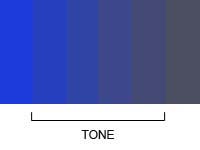 |
| Toner Toner is technically an alternative to ink, and is commonly used in laser printers. It consists of carbon powder, iron oxide and a polymer, and is inserted into the printer within in a cartridge, in its powdered form. When the powder meets the heat of the fuser within the printer, it is affixed (fused) to the paper. |
| Toulouse-Lautrec, Henri 1864-1901: a French painter, printmaker, and illustrator of the post-Impressionist style, best known for his brightly colored posters. We offer many classic art prints of Toulouse-Lautrec's work. |
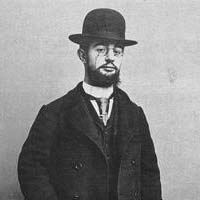 |
U ^^Top
Underexposed In photography, exposure relates to the amount of light that was allowed to affect the image, either through the viewfinder of the camera, or in the darkroom during film development.
An underexposed image will have less light than an average image (generally considered too too, though some artists deliberately underexpose their images). Underexposure tends to make an image greyer, obscuring details in areas that were already quite dark.
|
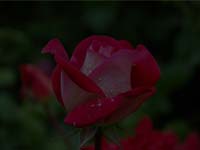 |
Underpinner A machine, generally operated manually with pneumatic assistance, that is used to join picture frame length moulding in the construction of the frame. The mitered corners of two moulding pieces are set together on the machine to create a 90 degree angle. When a lever or button is pressed, a foot is lowered to hold the pieces down, while V-nails or other fasteners are forced into the underside of the wood, holding the corner together.
Order online: Underpinner Wedge Nails |
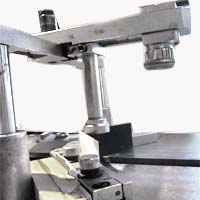 |
| United Inch United inches is a term used in the framing industry to describe the size of a print for the purpose of pricing. The number of united inches in any given image is the sum of its length and its width (one side only for each). Thus, in effect, it represents 1/2 the perimeter of the print. For example, an image that is 10 x 20 has 30 united inches, and a 24 x 36 inch print has 60 united inches. |
Unprimed Canvas An artist's canvas that has not been treated with a clear or white primer. As a result, when the paint is applied, it is readily absorbed into the fibers of the canvas, affecting the appearance. Though whether or not to use unprimed canvas is the choice of the artist, in the case of oil painting unprimed canvas can be problematic, since the oil paints will cause the raw canvas to rot. In addition to creating a smoother surface for the paint, primer protects the canvas from the elements.
Order online: Artist Canvas |
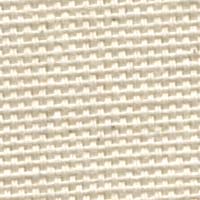 |
| UV Ultraviolet light. UV rays are beyond the visible spectrum of humans. UV radiation comes from a variety of sources, including the sun, lamps, LEDs, lasers, etc. |
| UV-Curable Printers Printers that use inks which are cured by UV light prior to exiting the printer. The result is color that is more durable and requires less protection. The inks can also print directly onto foam core, poster board and other rigid surfaces. Critics of this relatively new process feel color intensity is lost. |
V ^^Top
Van Gogh, Vincent 1853-1890: A Dutch post-Impressionist painter best known for his unique use of color, and the piece "Starry Night."
We offer many van Gogh classic art prints in our gallery.
|
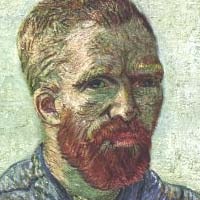 |
| Vignetting Underexposure of image corners produced deliberately by shading or unintentionally by inappropriate equipment, such as unsuitable lens hood or badly designed lens. A common fault of wide-angle lenses, owing to reflection cut-off, etc. of some of the very oblique rays. May be caused in some long-focus lenses by the length of the lens barrel. |
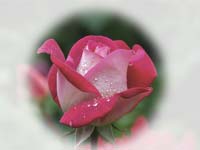 |
W ^^Top
Watercolor painting Watercolor painting is a painting method. A watercolor is the medium or the resulting artwork, in which the paints are made of pigments suspended in a water soluble vehicle. The traditional and most common support for watercolor paintings is paper; other supports include papyrus, bark papers, plastics, vellum or leather, fabric, wood, and canvas. In East Asia, watercolor painting with inks is referred to as brush painting or scroll painting. In Chinese and Japanese painting it has been the dominant medium, often in monochrome black or browns. India, Ethiopia and other countries also have long traditions. Finger painting with watercolor paints originated in China. |
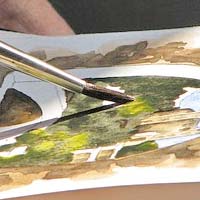 |
Watercolor Paper Watercolor paper is a specialized type of paper designed specifically for use with watercolor paints and techniques. Watercolor paper is characterized by its thickness, absorbency, texture, and durability, which allow it to withstand the application of wet media without buckling, warping, or deteriorating.
Watercolor paper is typically made from high-quality cotton or cellulose fibers and is available in various weights, surface textures (such as rough, cold-pressed, and hot-pressed), and formats (such as sheets, pads, and blocks). The choice of watercolor paper depends on factors such as painting style, technique, desired effects, and personal preference. Rough-textured papers are favored for expressive brushwork and organic effects, while smooth papers are preferred for detailed work and controlled washes. |
| Wet Mounting The process of adhering a print to a rigid backing such as foam core, gatorboard or wood using a wet adhesive (glue, paste) that adheres as it dries. In contrast, dry mounting uses a "dry" adhesive that is activated by heat rather than air dryinh. |
White Point White point, also known as chromatic white or reference white, refers to the color temperature or chromaticity coordinates that define the neutral white appearance of a display device or imaging system under standard viewing conditions. The white point represents the color of pure white light perceived by the human eye and serves as a reference for calibrating and reproducing accurate colors across different devices and media.
Common white point standards include D65 (daylight with a correlated color temperature of 6500 Kelvin) for graphic arts and photography, and D50 (daylight with a correlated color temperature of 5000 Kelvin) for color matching and proofing applications. White point calibration ensures consistency and color accuracy in digital imaging, printing, and display technologies, preventing color shifts, tinting, and inaccuracies in color reproduction. |
| Wilhelm Imaging Research A company that researches the stability and preservation qualities of digital images and film. They publish data regarding the inkjet printers used for giclée printing. |
Wire Hoops Any type of hanging hardware that provides a loop or eyelet through which wire can be threaded. Generally, two hoops are attached to the frame or canvas, one on each vertical arm, 1/3 of the frame's size down from the top. Depending on the size/weight of the artwork, the hook may be affixed with one, two or as many as four screws or nails. The wire is then twisted around each hook, with a bit of slack in the middle to allow it to be hung over a nail or wall hook and displayed.
Order online: Ring Hangers |
Wood Panels A wood surface suited for arts and crafts or anything imaginable. These Hardboard Panels offer an archival alternative to stretched canvas. This rigid support is best for non flexible media such as tempera, and casein paints or even Resin Coatings.
- 15/16" Standard or 1-5/8" Profile deep - with Baltic Birch plywood Surface
- Wood panel, art panel, Hardboard Panels, Birch plywood Surface are the other names.
Order online: Wood Panels |
Wraparound effect This effect is created when canvas is mounted onto a wooden frame, stretched around the sides, and fastened with staples in the back. In the instance of an "image wrap", the front image is continued around the sides of the frame, creating a continuous, angled viewing area.
Create your own, unique wraparound wall hanging with a custom made Giclée canvas print. |
Y ^^Top
Yellow CMYK is a color model used in color printing and reproduction processes. It stands for Cyan, Magenta, Yellow, and Black, representing the four primary colors used in subtractive color mixing. In CMYK printing, each color is represented by a separate ink or toner, and varying combinations of these four colors can produce a wide range of colors and tones.
Cyan, magenta, and yellow are subtractive primary colors, meaning they subtract or absorb specific wavelengths of light, while black (K) is added to improve color depth and contrast. CMYK is commonly used in commercial printing processes, such as magazines, newspapers, and packaging, where precise color reproduction and consistency are essential. |
Yellowing A process that results in discoloration of a mat board, backing, Resin Coating or artwork paper. Yellowing is caused by exposure to light, or chemical reactions that cause the substances added to whiten the paper to break down over time.
Though sometimes a desired look, yellowing is generally detrimental to artwork, and affects its longevity. |
|

|



|
USA Giclee On Canvas, Fine Art Printing - Art Scanning & Reproductions - Handmade Oil Paintings - Custom Wood Panels, Metal Picture Framing - Block/Plaque Mountings, Large Format Dry Mounting & Lamination - Art Supplies: Stretcher Bars, Cradled Wood Panels and Artist Canvas - Collages On Canvas - Plexi/Acrylic Face Mounts - Block Acrylics, Fabric Printing, Dye Sublimation - Cityscape Skyline Prints, Resin, Photo Gifts and more...
Frame Assembly Guide - Dovetail System
USA Laser Engraving & Cutting Services
|
|
© 2002-2024 - KeenART Media Ltd.
|
|
| |
|
